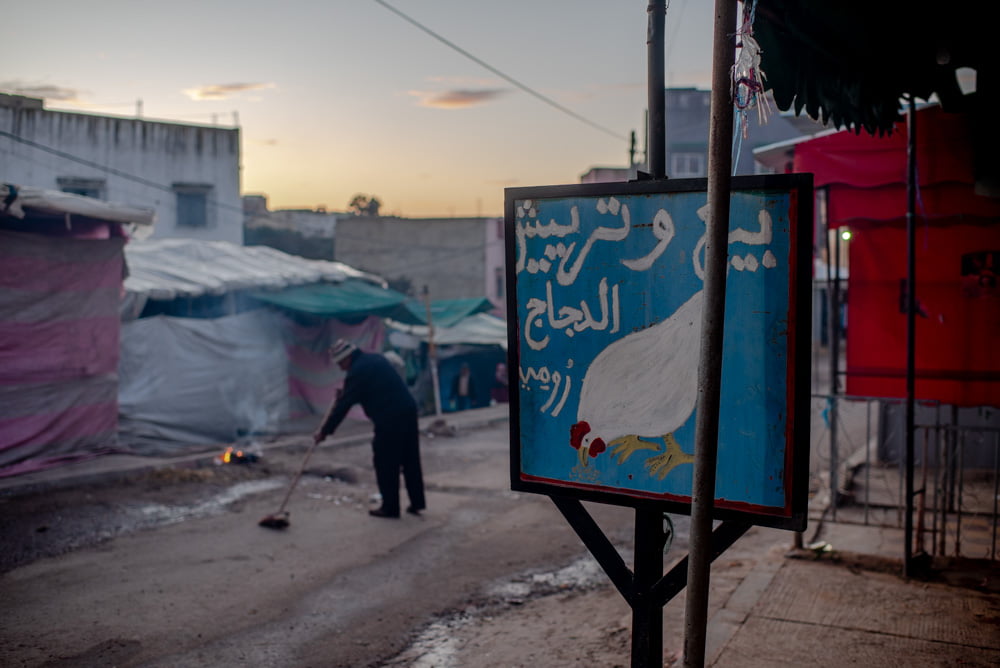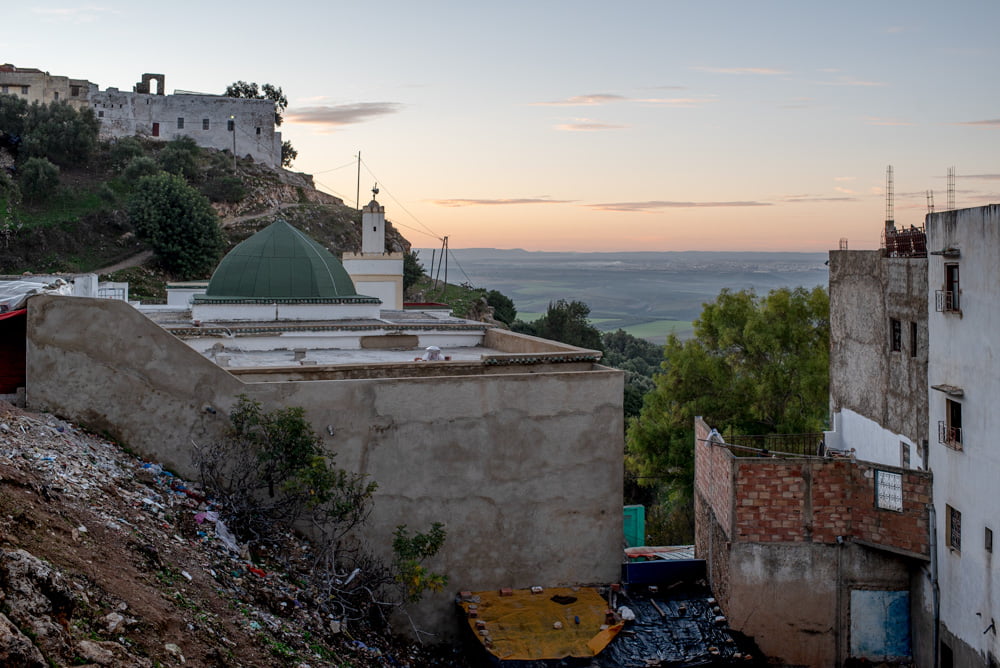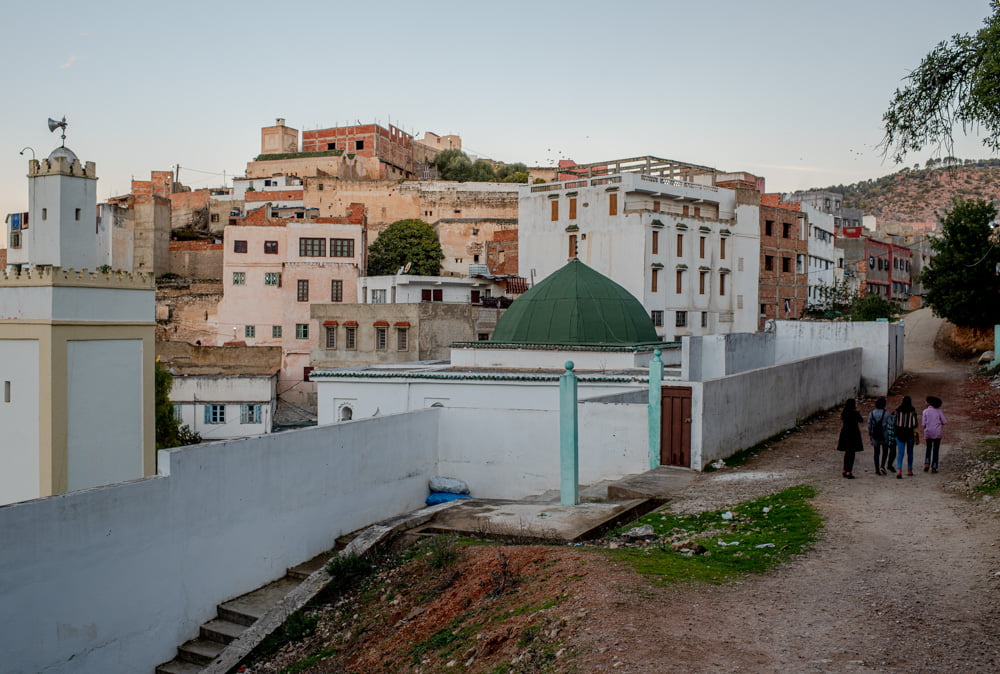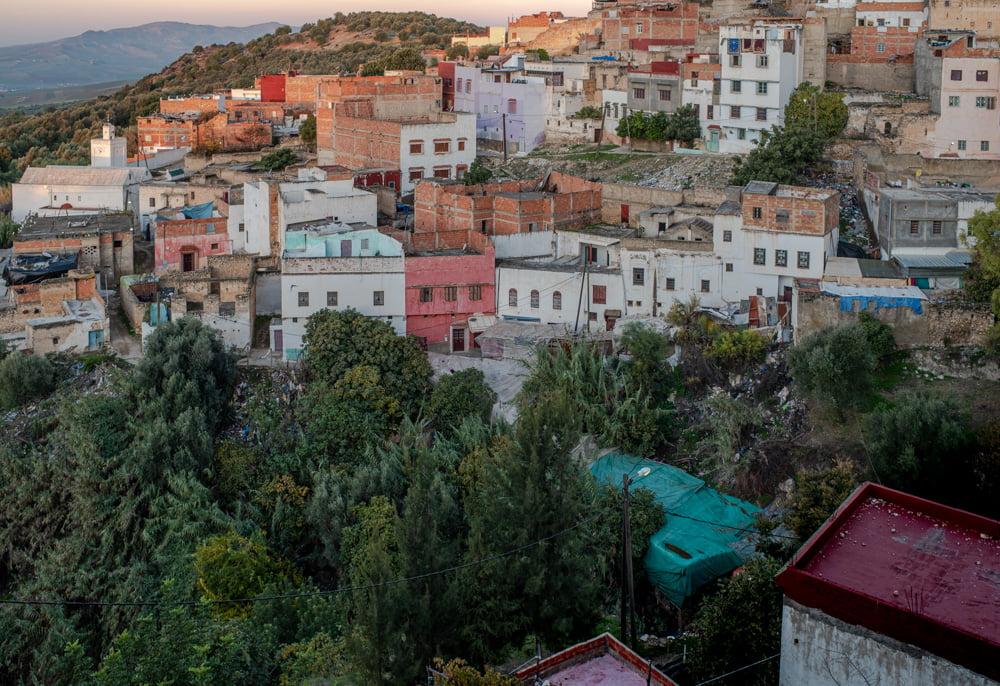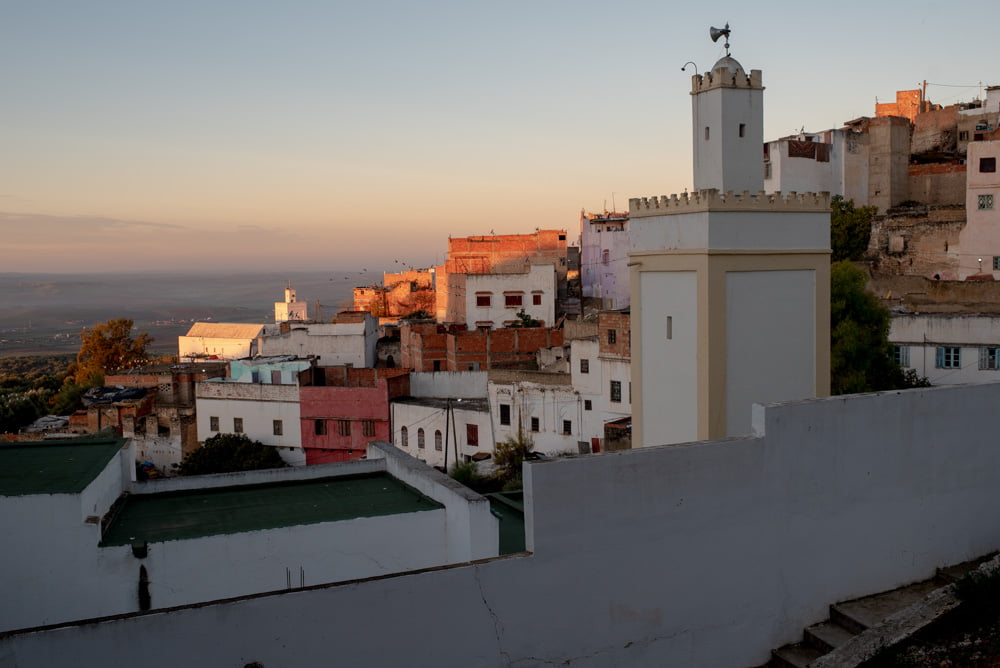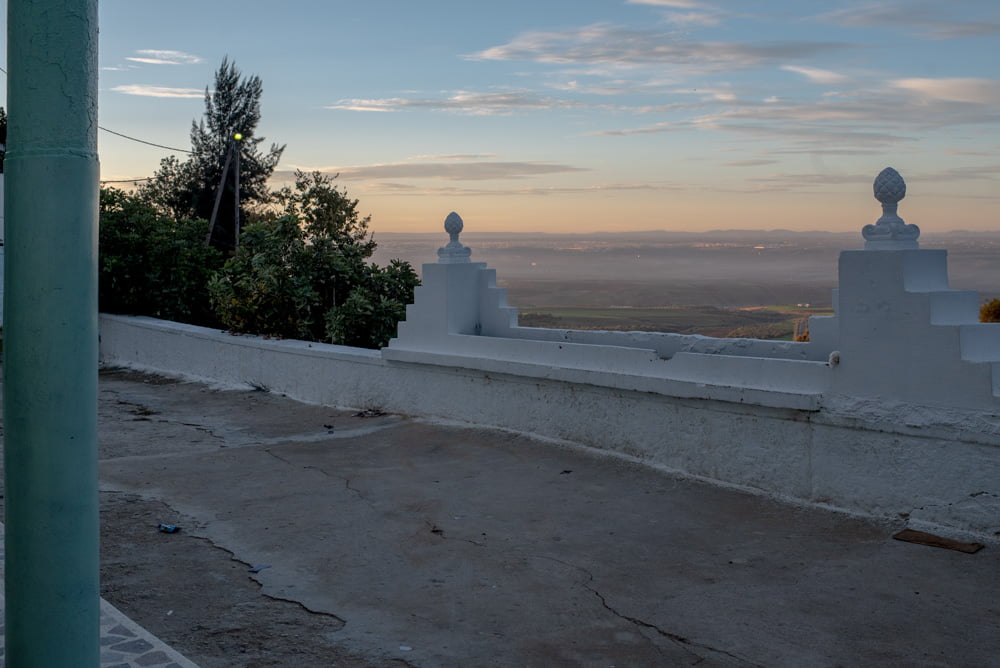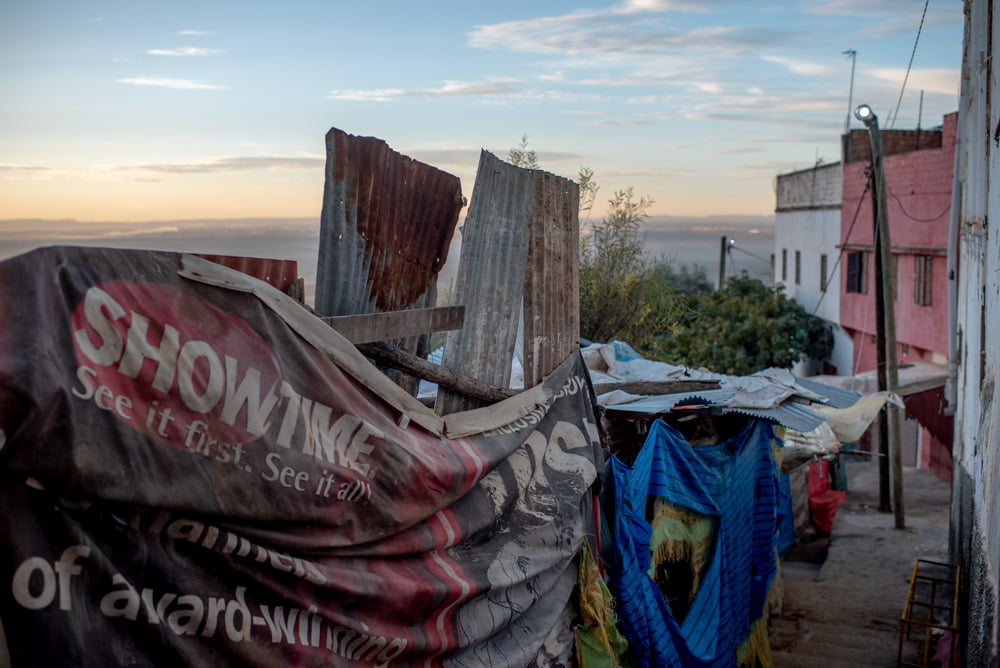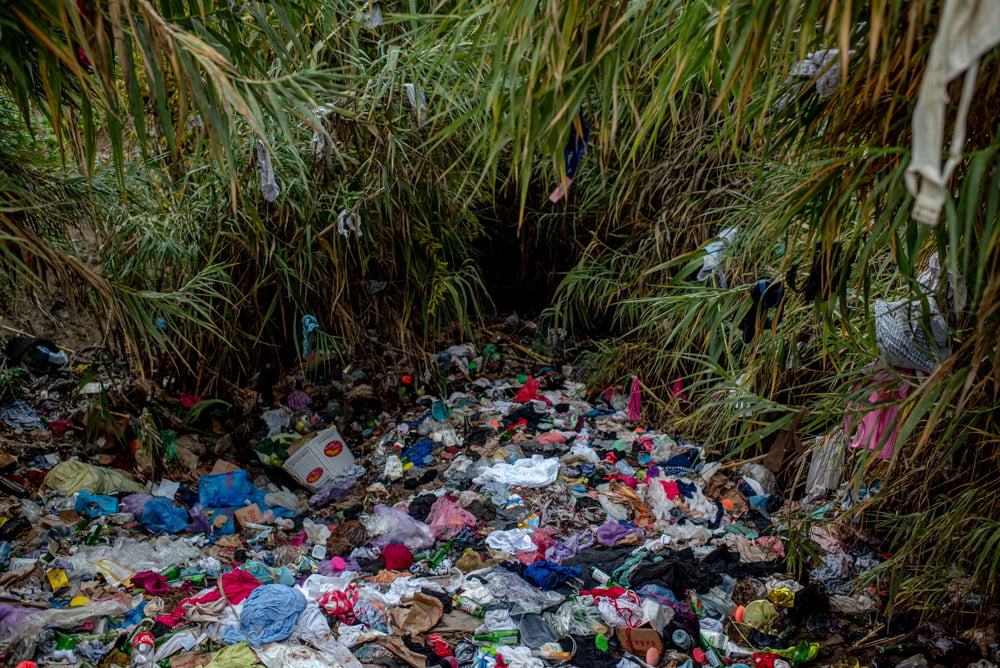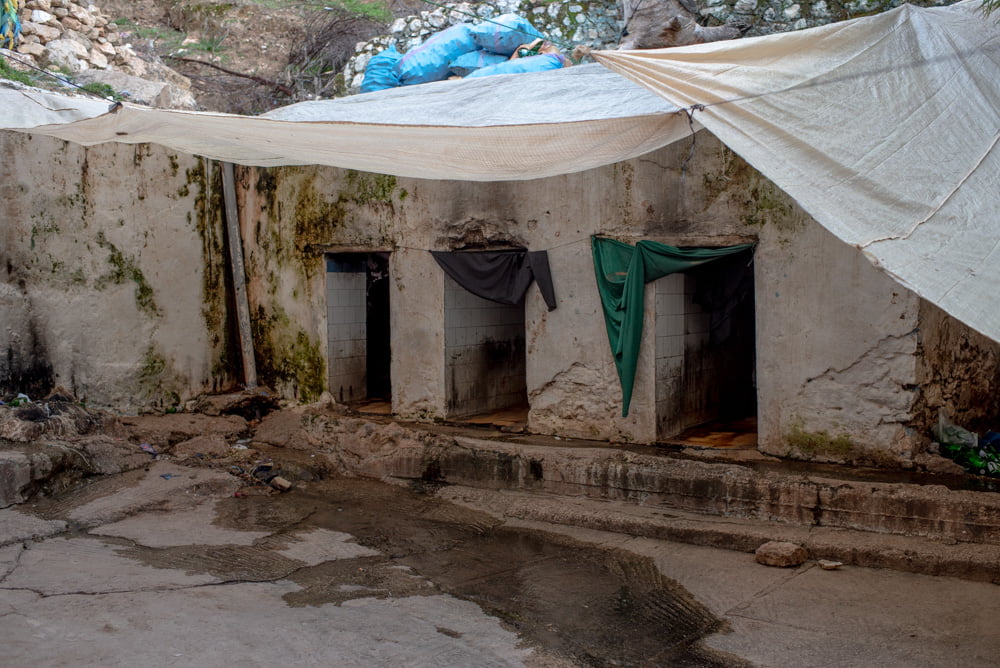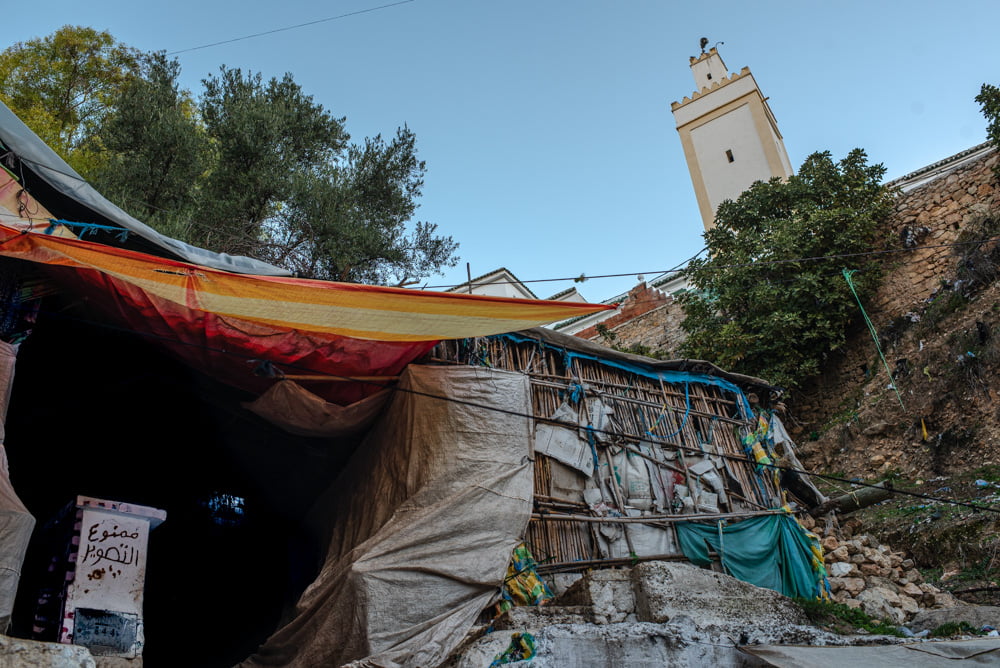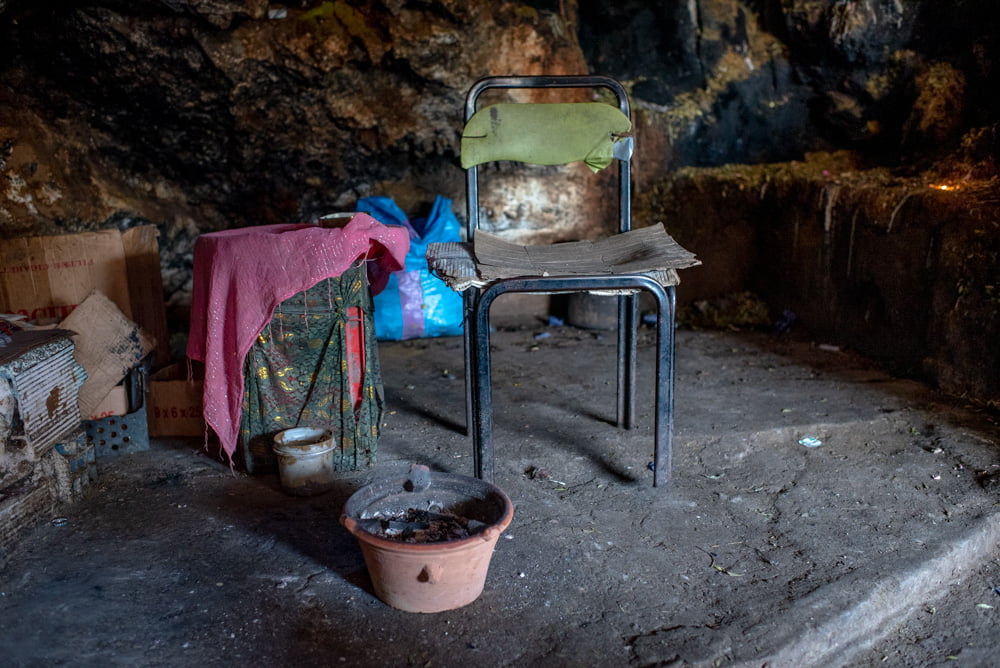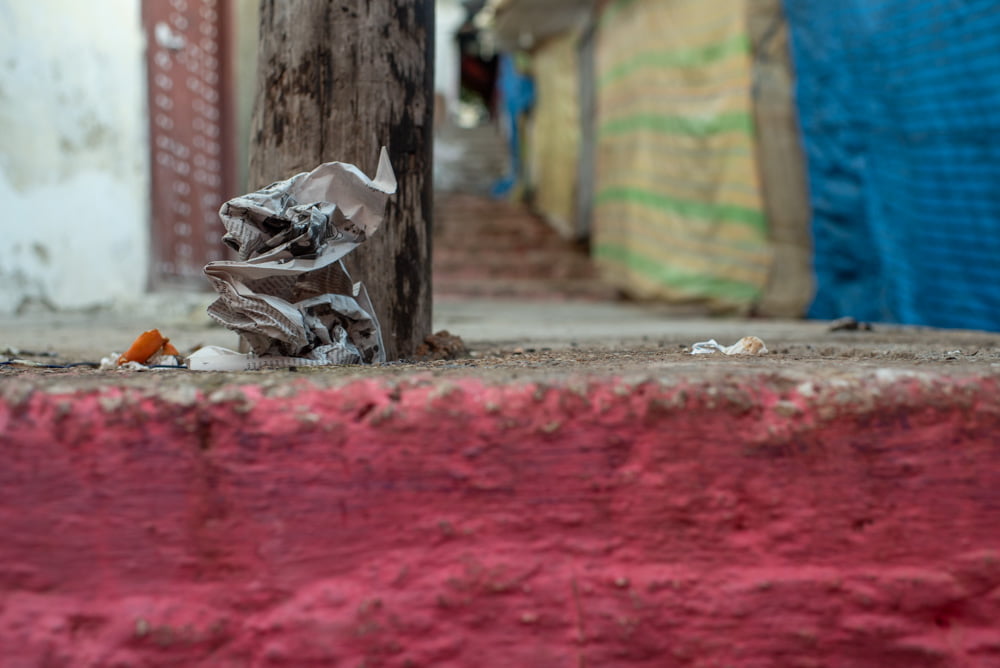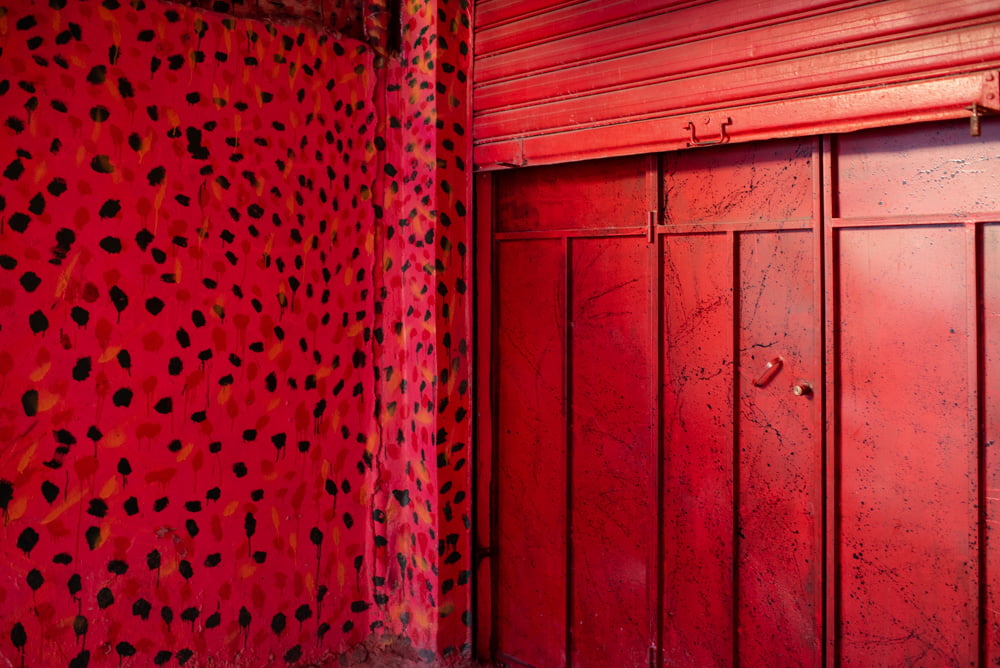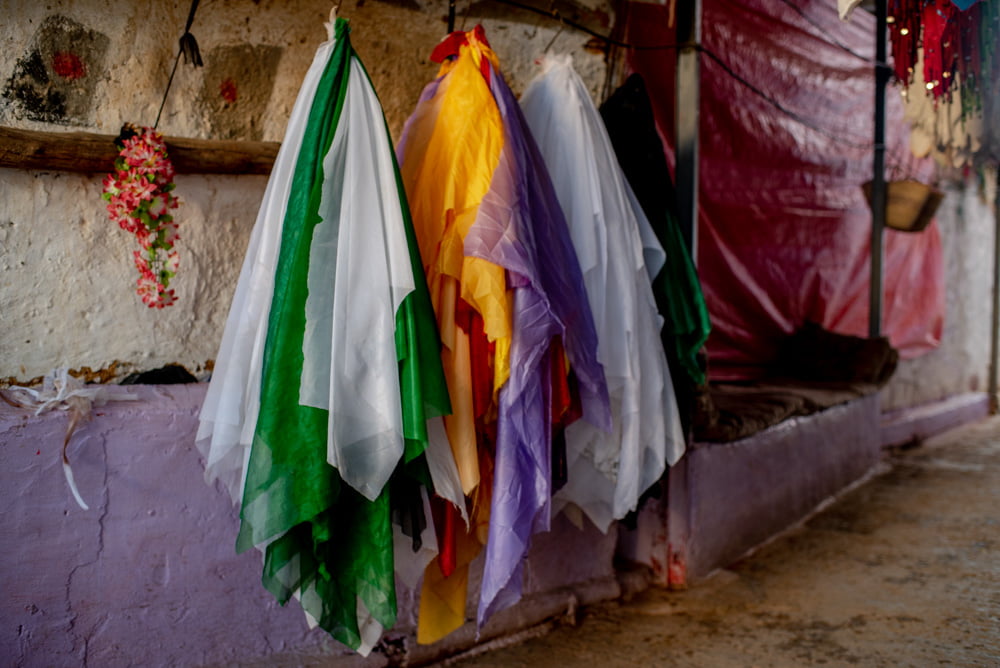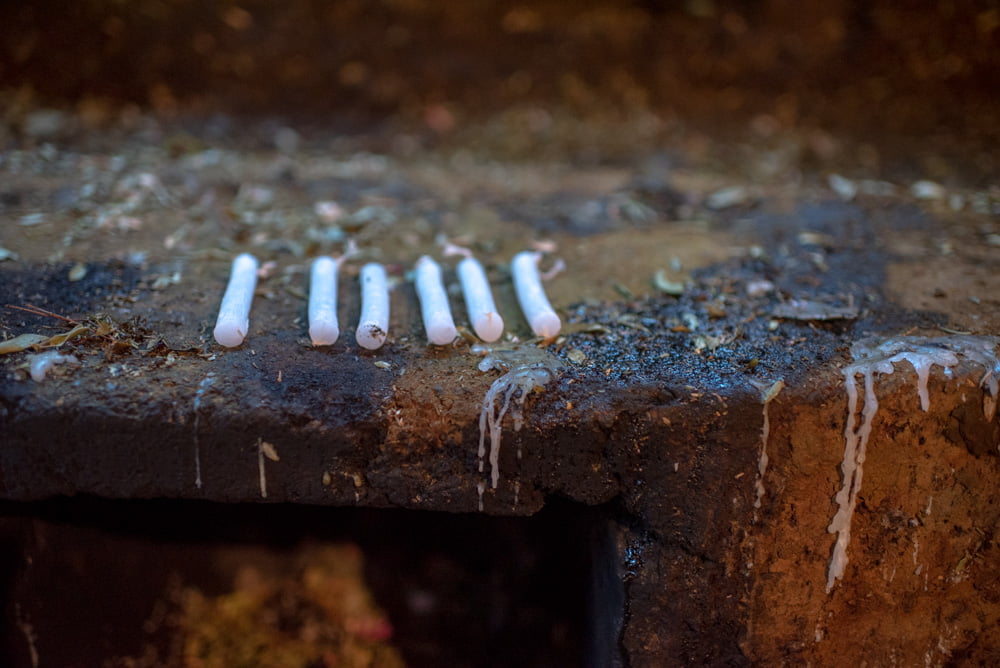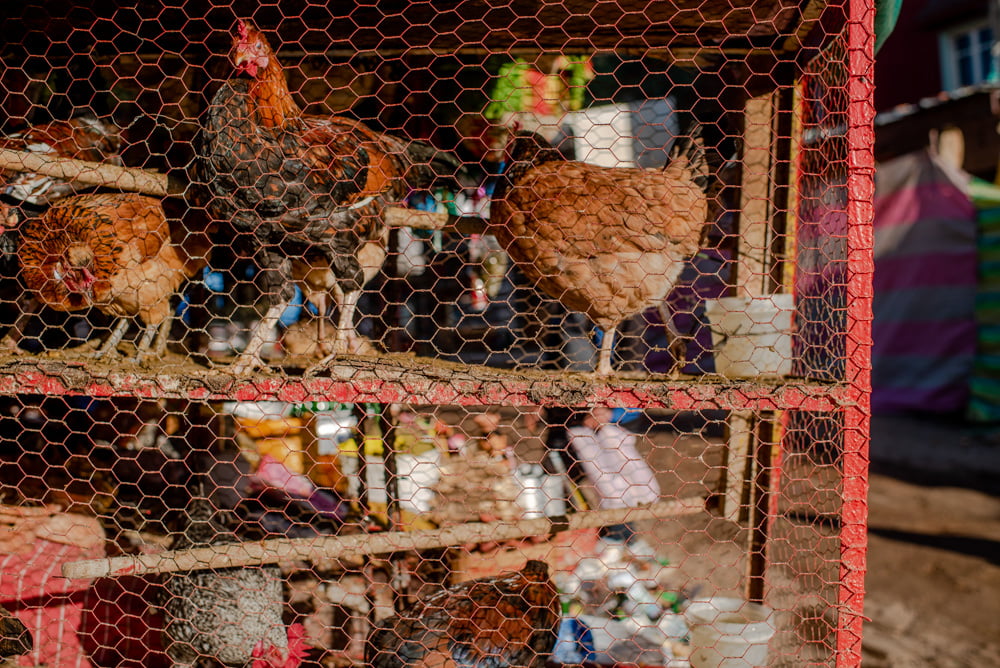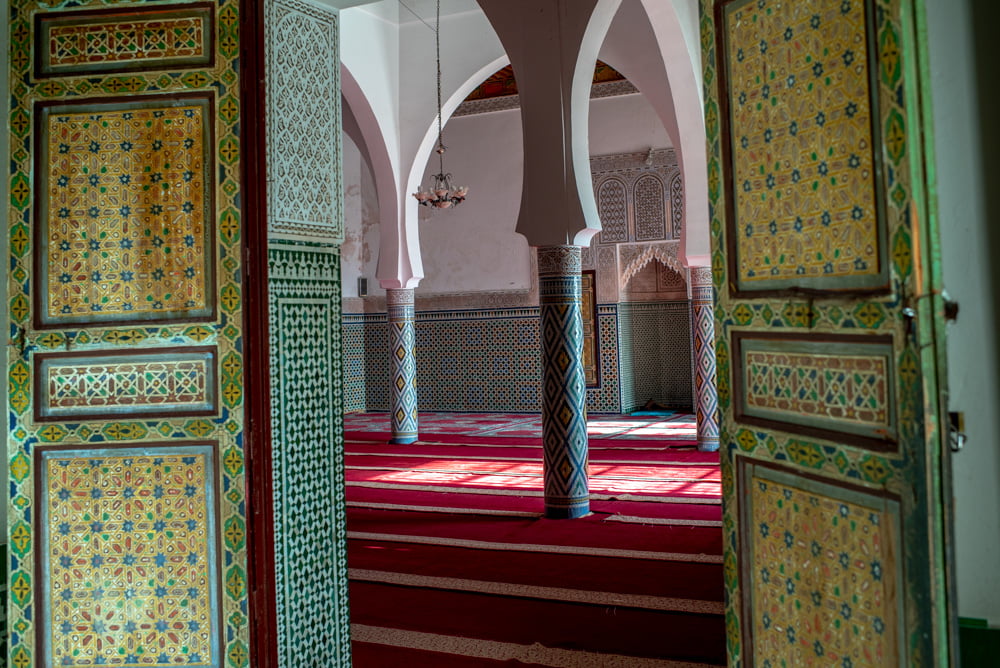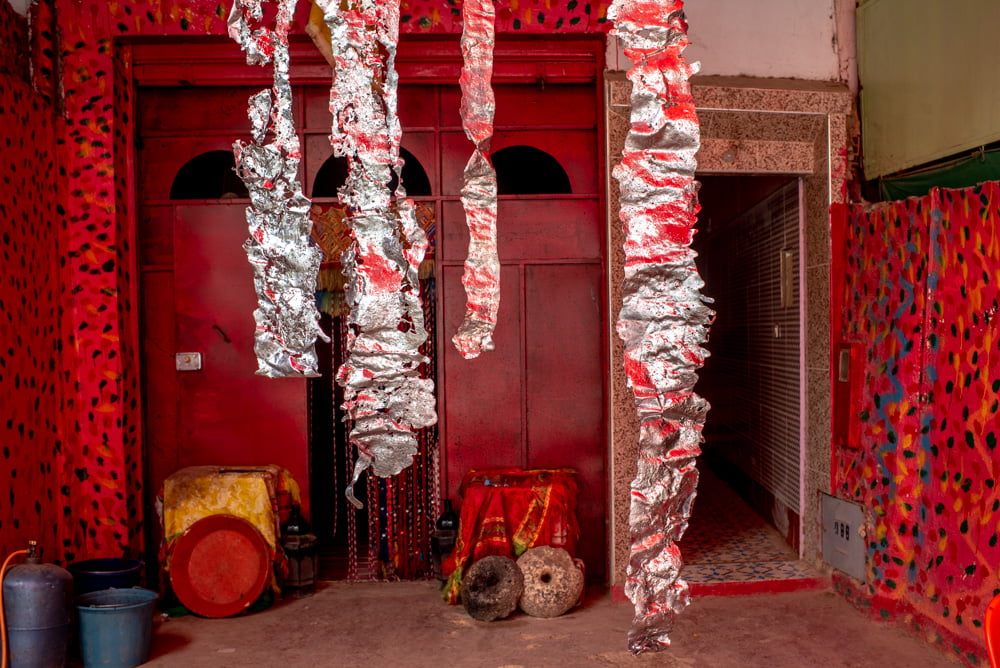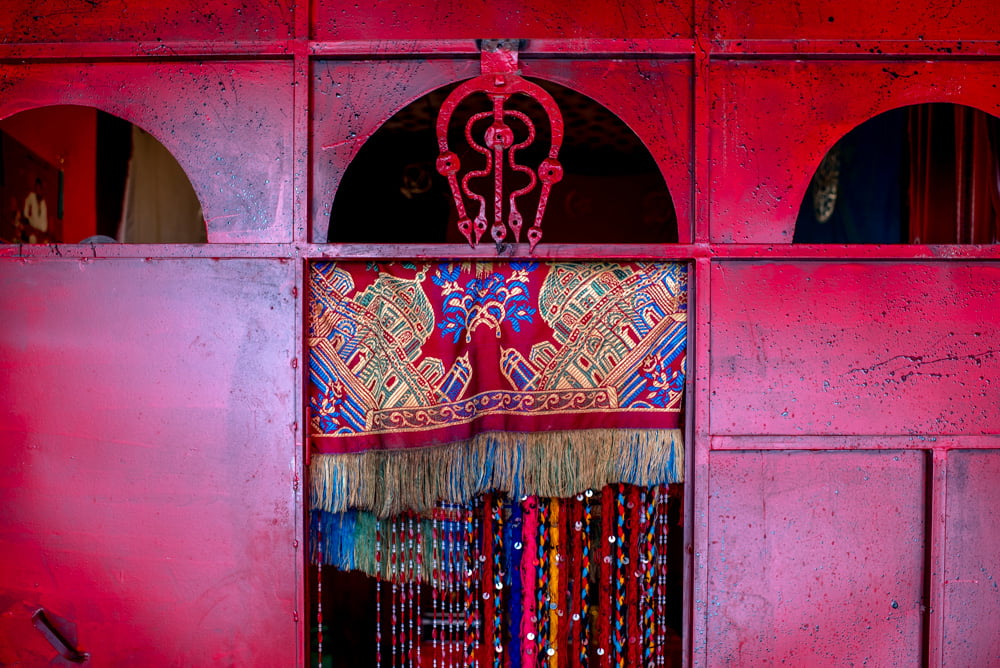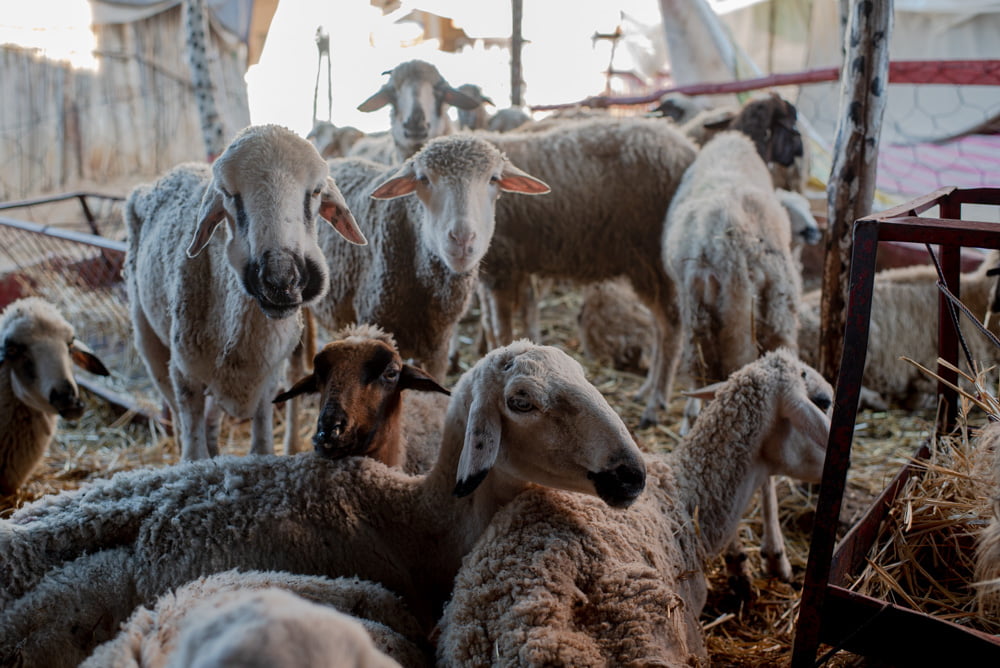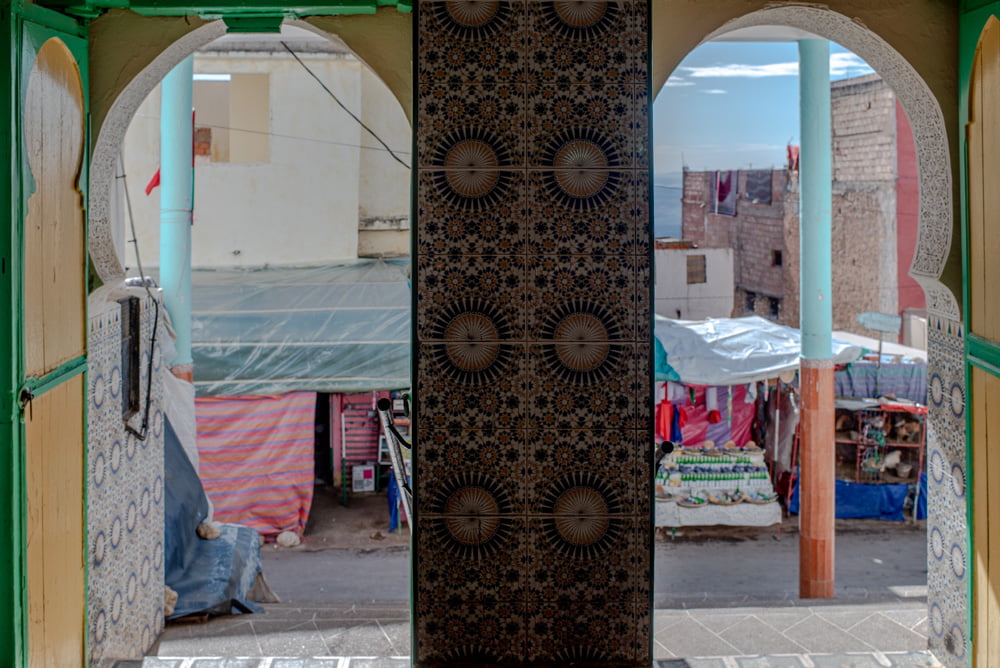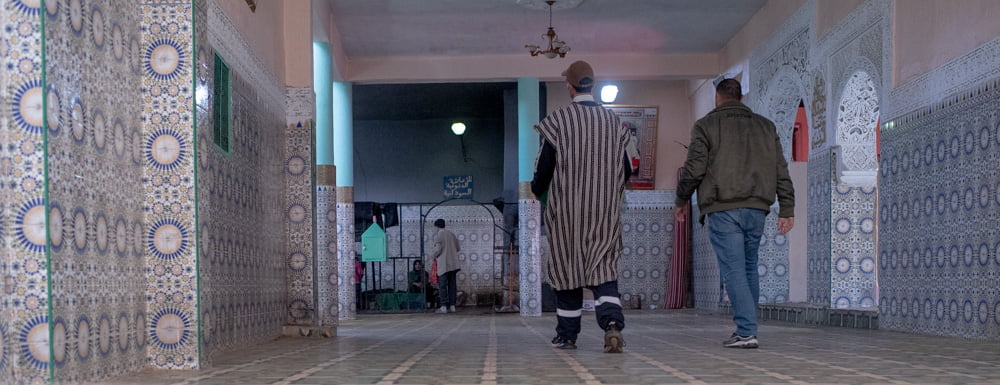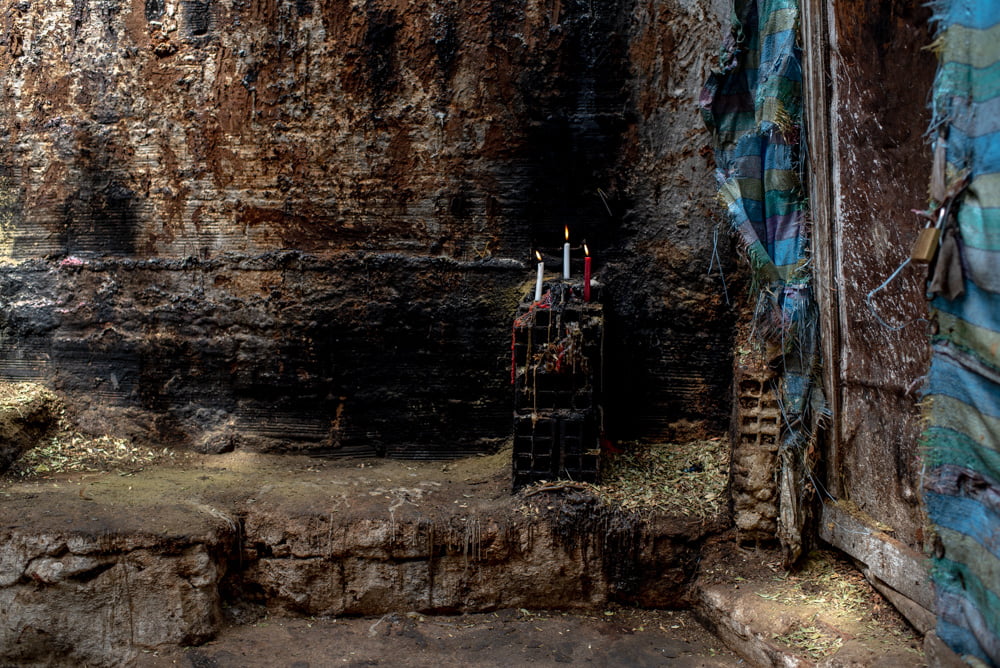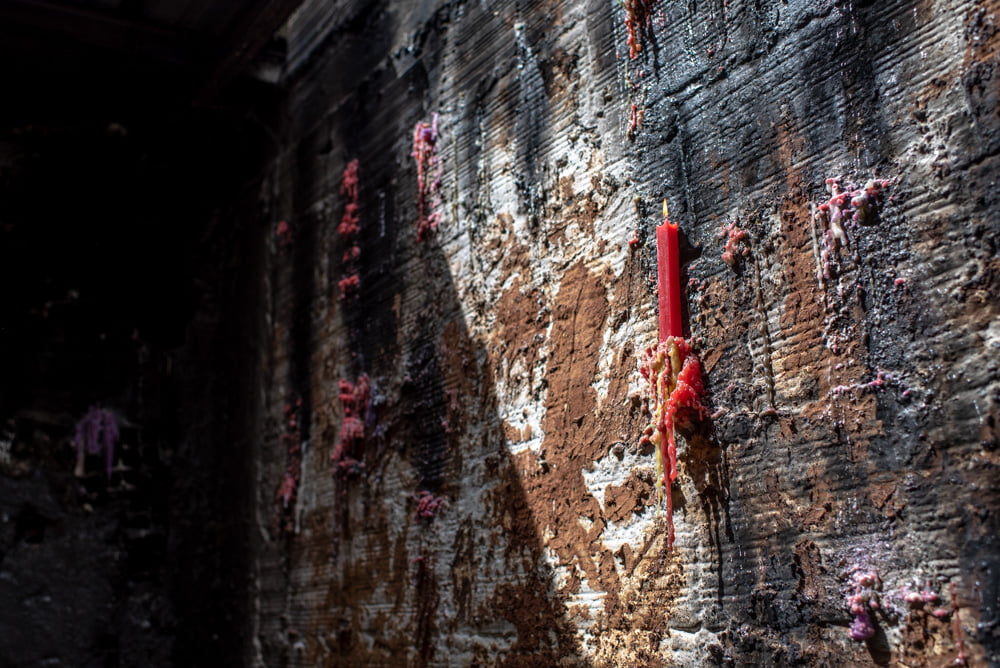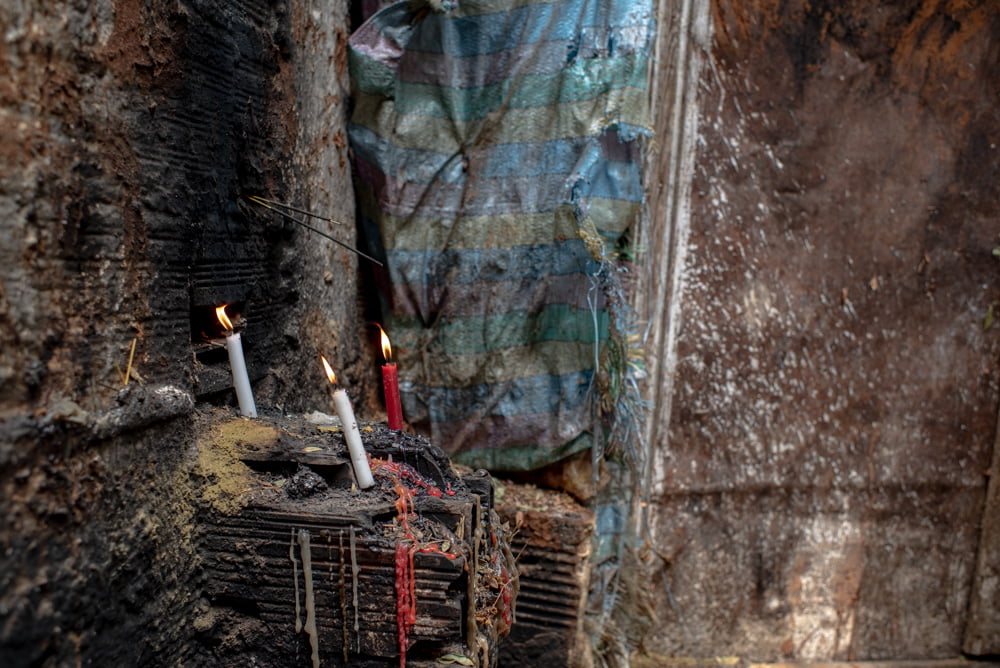You know that you have arrived at the correct destination when the hotel proprietor seriously enquires whether you would like to sacrifice a sheep the following day in the grotto of Lalla Aisha. I had arrived at possibly the strangest place yet on my travels through Morocco.
The small town of Beni Rashid on the Zerhoun mountain is better known as Sidi Ali, named after the 17th century sufi saint Sidi Ali ben Hamdush. His tomb lies in his zaouia in a small gulley at the edge of the town looking out over the fertile valley where Meknes can be seen in the distance. Of more significant interest is that Sidi Ali is bound by legend to another sufi saint, Sidi Ahmad Dghoughi, his disciple and servant, who is buried in the nearby village of Beni Ouarad, and that they are both bound by legend to a hostile but beautiful female spirit ( jinniya ) called Aisha Qandisha.
It is a love triangle with a difference; the legend describes how Sidi Ali’s baraka was transferred to Sidi Ahmed upon his death, how the Hamadsha brotherhood obtained its traditional ‘hal’, that is ecstatic dance, how music and its healing role of people came into being, how the Hamadsha acquired its self-harming behaviours once in trance, and finally how the she-devil Aisha Qandisha became an integrated and indivisible part of the Hamadsha Sufi traditions.
The legend also describes the genesis of the cultural-medico concept of Ethno-Psychiatry where ecstatic dance and spirit expulsion, sometimes facilitated by animal sacrifice, has traditionally been first choice for treating a range of illnesses in Morocco.
Before I relate the legend, here firstly are a set of photographs of Sidi Ali taken at dawn on November 30th 2019. A number of notable mausoleo can be found on Zerhoun mountain including Morocco’s founder Moulay Idriss and of course Sidi Ali and Sidi Ahmed, and the mountain is considered sacred. The photographs here include points of interest from the legend as relevant to Sidi Ali and Aisha Qandisha.
Photographs of Sidi Ali around dawn on 30th November 2019
The Legend of Sidi Ali Ben Hamduch, Sidi Ahmed Dgoughi and Aisha Qandisha
Sidi Ali left the Qariwwyyne mosque in Fez and moved to the Zerhoun mountain for a quieter life. He instructed Sidi Ahmed, his disciple and servant, to run errands for him; these are both tests of manhood and worthiness as preparation for inheriting baraka. He was directed firstly to overcome the fearsome Abdelhaq, the son of Moulay Ismail known as the beheader; then he was instructed to travel to the Sudan to fetch and return the magical Hal ( ecstatic trance ). Sidi Ahmed remarked that the Sudan was 6 months travelling; Sidi Ali instructed Sidi Ahmed to close his eyes. When he opened them again he found he was outside of the king of Sudan’s palace. Seeing all the guards were asleep, he entered the palace and found a wwadf ( flute ), a doff ( drum ) and Aisha Qandisha, the king’s wife. The combination formed the Hal he was instructed to claim.
Sidi Ahmed took them all with him. Then the soldiers and the king awoke. The king asked them where his wwadf, his daff, and Aisha Qandisha had gone. The soldiers said they did not know and assured him that no one had entered while he was asleep. The king guessed that it must have been Sidi Ahmed who stole them and ordered his soldiers to follow the saint to the Ayn Kabir ( the great spring on mount Zerhoun ). Sidi Ahmed sent a message by pigeon asking Sidi Ali to pray for him so that he would not be taken prisoner. Sidi Ali used his baraka and the soldiers were all turned into frogs. When the king died, his body was taken to the Ayn er-Rjal at Moulay Idriss and buried. After his burial, whenever the inhabitants of Moulay Idriss prepared couscous or tajine, frogs jumped from their plates.
To seek a remedy, a sacrifice was made to Moulay Idriss, who woke and told them that they had brought the sacrifice to the wrong person, that they should go to Sidi Ali Ben Hamdush. The townspeople then went to Sidi Ali and told him that frogs were jumping all over the place. Sidi Ali asked them who had sent them, and when he learned that it was Moulay Idriss, he instructed them to return to their village where they would find a man dressed in a djellaba, sleeping. They were to ask him his advice, and he would tell them what to do.
They found the man, woke him, and asked him if it was he who had let out all the frogs. The man asked them who had sent them, and they they replied it was Sidi Ali; he then replied that they should perform the Hal of Sidi Ali and the problem would resolve. The people from Moulay Idriss agreed to do this and have followed and made sacrifices to Sidi AIi ever since.
When Sidi Ahmed returned to mount Zerhoun, he found his master Sidi Ali had died. He washed and buried his body in the spot where his zaouia now stands beside the spring of Ayn Kebir. Sidi Ahmed then climbed to the top of mount Zerhoun, where he became so upset that he slashed his head with an ax as he called out the names of all the saints. His followers tried to calm him. They told him that before Sidi Ali died, he had said “For you Thursday, for me Friday,” by which he meant that Sidi Ahmed had inherited his baraka ( a crucial transfer of saintly energy ) and would be visited first, on Thursdays, at the annual moussem and pilgrimage.
Then Aisha, now without Sidi Ali there to marry or serve, began to undertake miracles of healing. She healed those who would come from afar: the desert, Algeria, Tunisia, and other cities across Morocco. She saw many people before suddenly disappearing. No one knew what happened to her or where she was. Her cave, however, remained and became a pilgrimage site just downhill from the zaouia of Sidi Ali Ben Hamdush. Despite the fact that she was no longer there, the cave, where a great fig tree grew, became a place where one could bring a sacrifice, light candles, and be healed. This practice entered the tradition, as people would continue to visit and live within the proximity of her past and continuing miracles. Some consider her to live there though others suggest she has no home and just visits there as one of her shrines.
A secondary shrine, at the foot of Ayn Kebir, provides opportunities for bathing in the spring water which flows from the cliff just below Sidi Ali’s tomb. The water is considered to contain much baraka and has a healing role to pilgrims. Her second grotto is just up a few steps beside the baths.
Aisha has pivotal importance in the Hamadsha mythology both for representing and introducing the Hal, or ecstatic trance, as well as for her dual, contradictory nature as both a great healer as well as a great antagonist. The Hamadcha feel a great responsibility for healing those people afflicted by Aisha and have specialised in its treatment of those possessed by Aisha Qandisha.
Sidi Ahmed lived for several years more – he would continue to slash his head whenever he was falling asleep as he prayed – and when he died he was put on a mule, as he requested, and carried as far as the mule would go. The mule collapsed at Beni Ouarad, a mile from Sidi Ali’s tomb, and it was here that he was buried and that some of his descendants settled.
Sidi Ahmed is considered responsible for the traditional head slashing undertaken by members of the Hamadsha whilst in ecstatic trance. His trip to the Sudan is also considered to be the most important episode in all the legends of Sidi Ali and the Hamadsha; it explains the origin of the ecstatic trance, into which the Hamadsha work themselves whilst performing Hadra, their association with music and healing, and finally the arrival of and their intimate often contradictory relationship with Aisha Qandisha.
Sidi Ali
The town of Sidi Ali ( Beni Rachid ) is a small town on Zerhoun mountain, just a few miles from Moulay Idress, where worshipping the traditions of both it’s Saint and associated jinniya ( or female spirit ) is the most important business in town. Rows of shops selling penned animals for sacrifice, relics from dead animals and a host of other impedimenta for practicing shawafa ( witchcraft, divination or healing ) line its small alleys. Practitioners of these black arts offer their services in small consultation areas bedecked with prayer beads, candles, flower water and other spiritual offerings draws in the unwell, the not-coping and the superstitious eager for some change within their lives. Evidence of the co-morbid relationship between Sidi Ali and Aisha Kandisha and its insatiable demand for devotees is everywhere.
The sanctuary of Sidi Ali looks out over the plains towards Meknes. It is a large zaouia, with a room containing the mausoleum of the saint himself and an entrance to its mosque at the furthest end. Many people arrive throughout the day to remember and pay homage to the Sidi, saying prayers and sprinkling flower water at his tomb. I met two women who had travelled from Casablanca that day, by taxi and train, and were returning there that evening. Outside the shrine women sit providing a henna service. There is a special relationship between henna and the legends explored below.
Outside the shrine, there is a view down to the canopied douches, or showers, where the Ayn Kabir ( great spring and carrier of baraka from the saint’s tomb ) attracts many people each day. This is a place of healing, where it is traditional for pilgrims to cast off their clothing into the little group of trees there and wear new clothing after their shower, symbolising their new found health. A covered path of stalls selling shawafa items leads down to the douches. Beside the douch is a shrine to Aisha Kandisha where candles may be lit, henna offered and prayers made. Sidi Ali and Aisha Kandisha are inextricably bound, as are Aisha Kandisha and Sidi Ahmed in the nearby town of the same name.
In Sidi Ali it is impossible to escape the aroma of sacrifice, the symbolism of the traditions of old Morocco and the presence of the protagonists in a 300 year old legend. Manifestations of traditions are all around, and defy modernity and scientific progress. Entering Sidi Ali is like returning to an earlier time.
However, as an indication of how much of the spiritual landscape is shared between the Sufi/Trance/Healing confraternities in Morocco, it is not just the Hamadcha brotherhood that is represented in Sidi Ali. There is much evidence of Gnaoua influence, from the music which is played accompanying sacrifice, the selling of Gnaoua paraphernalia in the stalls and the dress that some of the local people choose to wear.
There is a moussem, or festival, once a year in Sidi Ali where the legend is remembered and honoured,
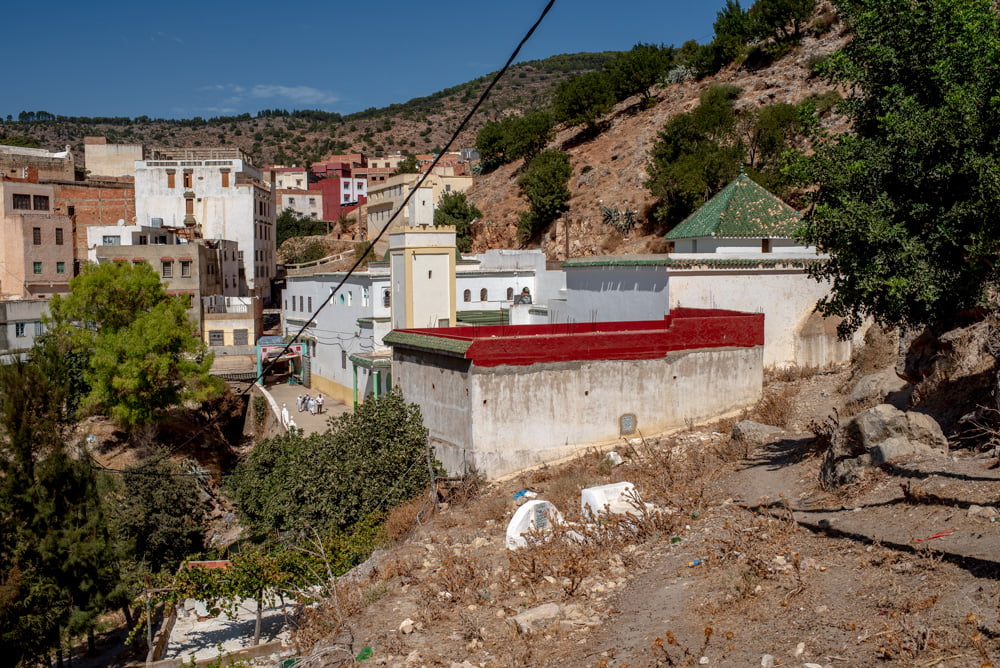
The zaouia and mosque of Sidi Ali looking back into the town. The cliff face leading down to the spring and douches can be seen to the left of the zaouia
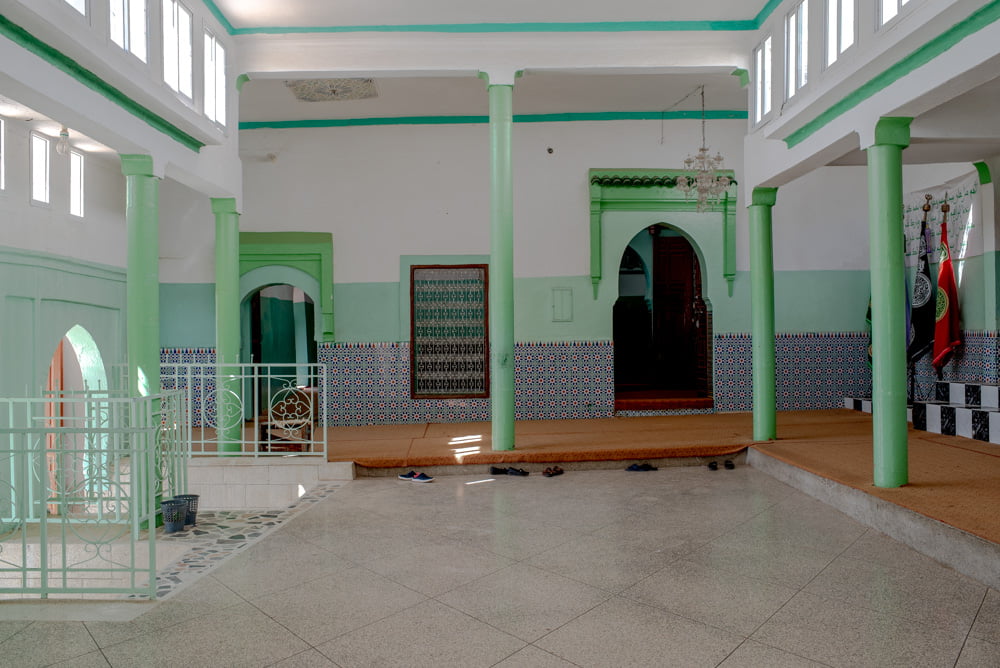
Inside the zaouia of Sidi Ali looking towards the mausoleum of the saint through the larger of the 2 archways. No photography was allowed, certainly not in the mausoleum. People sprinkled rose water over the tomb and over their hands.
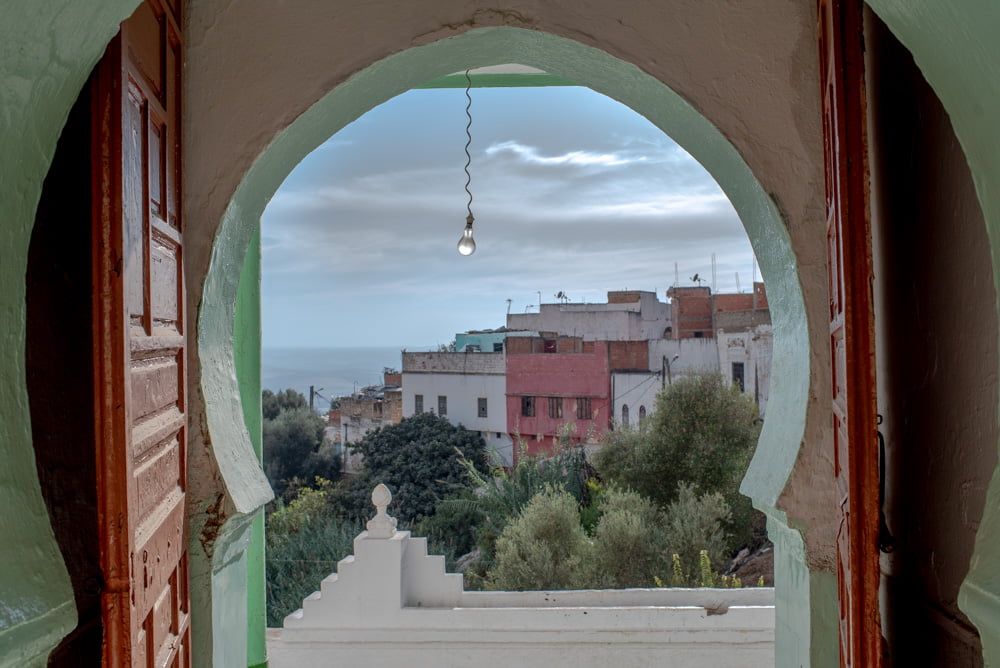
The view looking out from the arched entrance to the zaouia, both towards the houses from the small town and the distant plain where Meknes is situated.
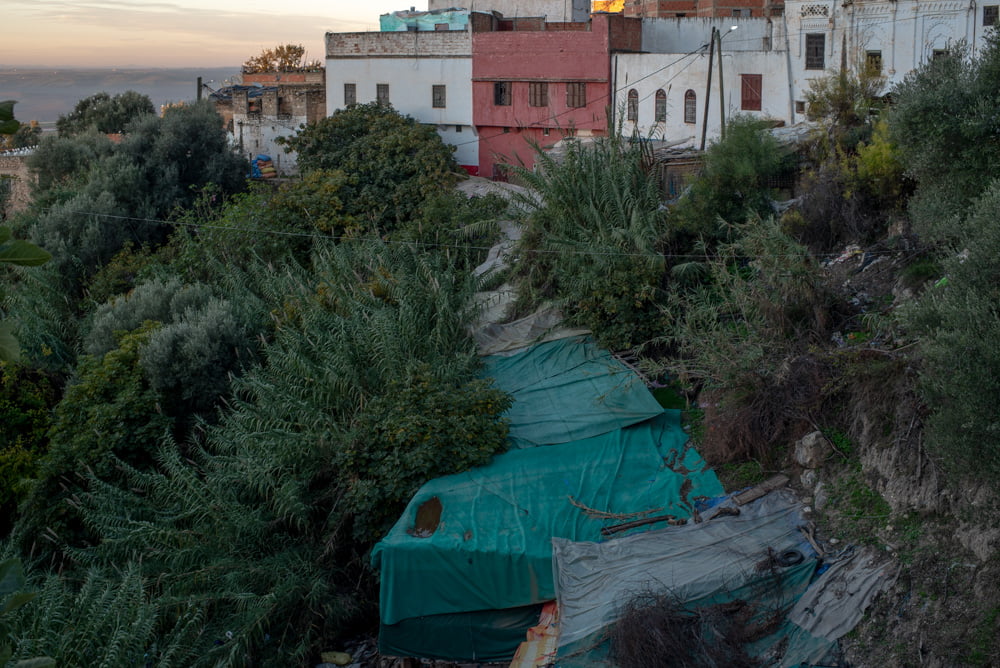
The covered stepped passageway down to the douches and Aisha Qandisha shrine. Under the covers and all along the passageway are a series of shawafa items which can be seen in the Aisha Qandisha notes below.
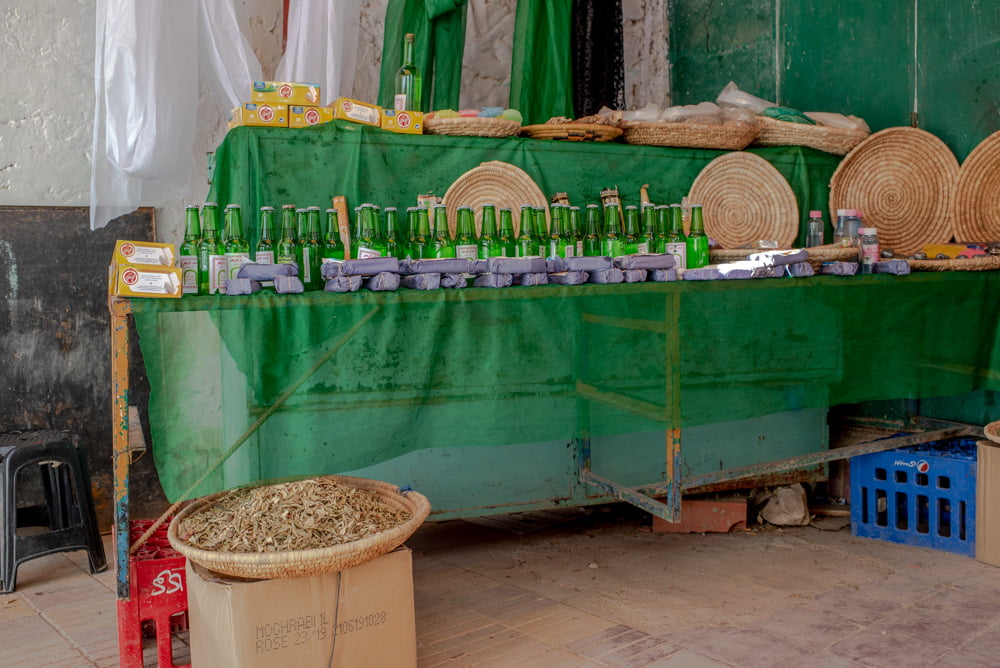
Just outside the zaouia are stalls selling offerings to the saint. Rosewater, coloured cloths, milk, rice, candles are common. People take offerings into the shrine on the wicker platters visible in the photograph.
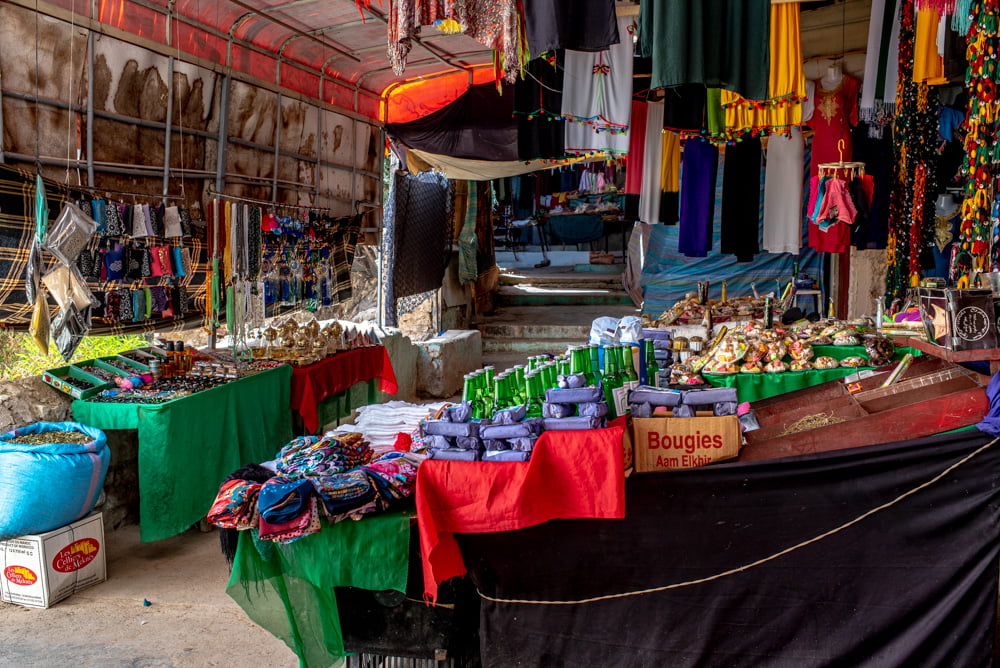
The stalls lead away from the zaouia and down towards the douches and Aisha Kandisha shrine. Here clothing can be seen amidst the other offerings; it is common for clothing to be shed after a douche symbolising healing.
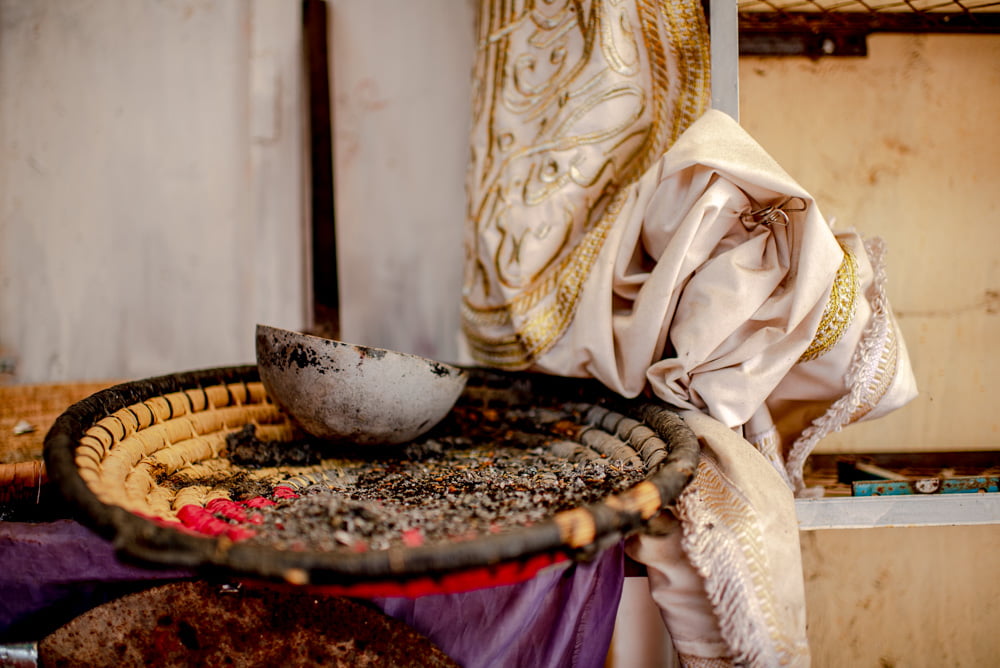
The pathway to the douches leads to some practitioners of shawafa, using all sorts of things including boiling lead to forecast the future, make spells and cure sickness. Here is a ladle to work with boiling lead in water, the steam from the boiling water is considered healing and the formation of the lead following melting conveys clues for the future. People often ask for divination about love interests.
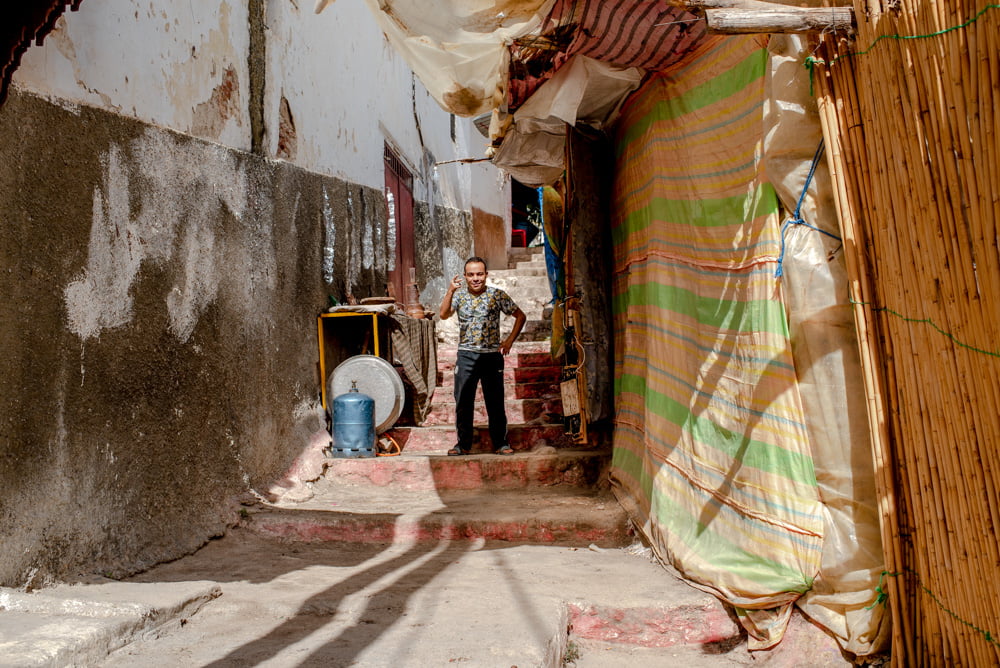
A practitioner of shawafa in an alley leading down towards the douches and Aisha Kandisha’s shrine. He melted lead and had private consultations with clients in the shack beside him.
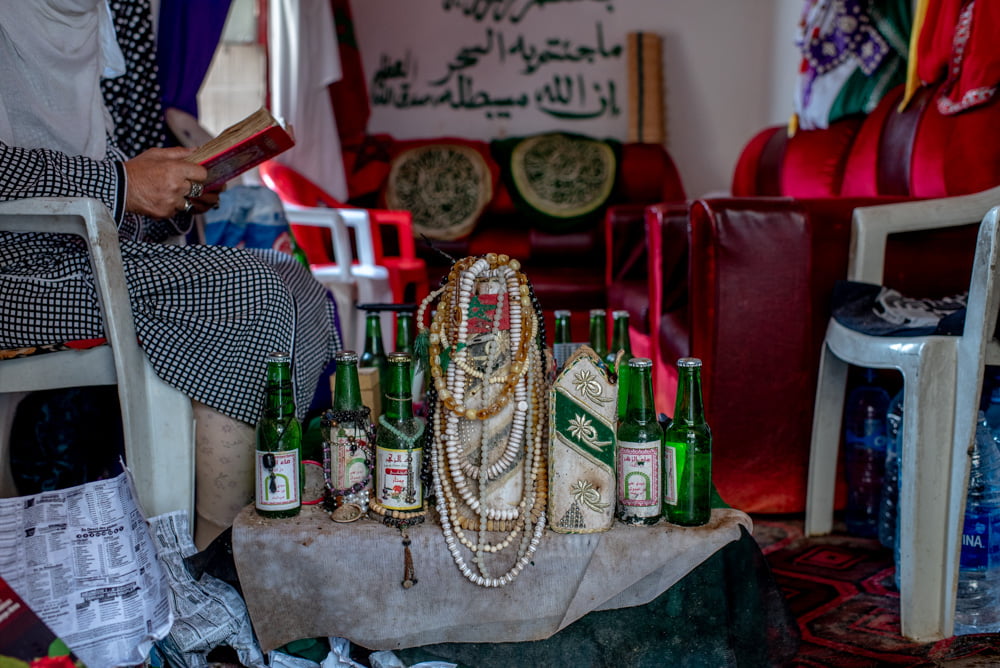
Private consultation room of a shawafa practitioner, with prayer beads, flower water, koranic inscriptions and a small book of koranic prayer for healing.
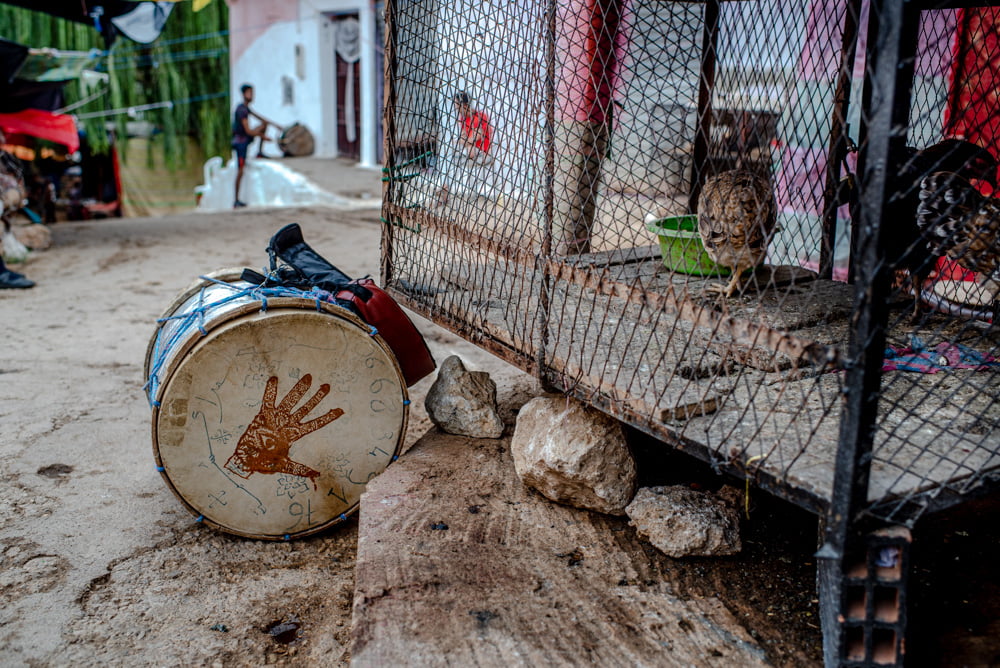
Musical instruments can be seen throughout the town. Here is a Gnaouan drum used to accompany offerings for sacrifice to Aisha Kandisha’s shrine in her sanctuary at the giant fig tree. The hand signifies the Hand of Fatima, used to keep bad spirits at bay. Pens holding animals which can be bought for sacrifice are all around. These are chickens in this pen.
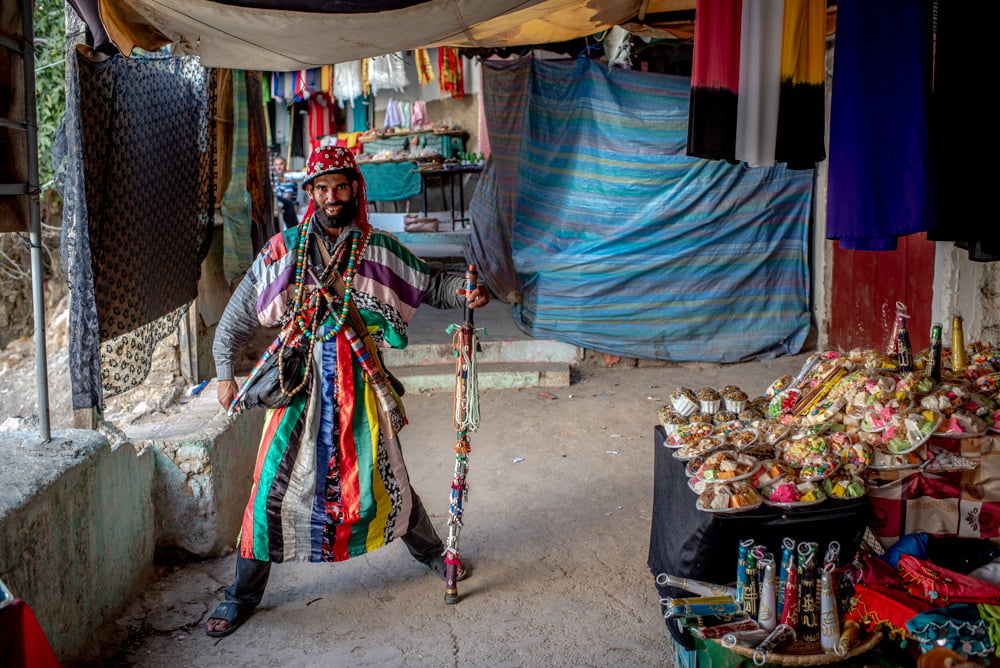
This man is wearing the colours of Gnaoua. What is interesting, and I have not seen elsewhere, is that he carries a ceremonial sword, musket and dagger, all bedecked in prayer beads and colour. He gives the impression of being a ceremonial warrior. He is frequently seen around Sidi Ali, both in the zaouia and in Aisha Qandisha’s grotto.
Sidi Ahmed
Sidi Ahmed is just a short walk from Sidi Ahmed. I have read there is a trackway which leads between the two small towns, but I reached Sidi Ahmed by following the road beyond Sidi Ali and turning first right, entering the town after a few hundred yards of walking. The donkey which, according to legend, carried Sidi Ahmed following his death as far as possible before collapsing could not have been very healthy.
Sidi Ahmed is much smaller than Sidi Ali and there is very much a focus of the spiritual role of the town around the zaouia of Sidi Ahmed. Whereas in Sidi Ali the shawafa stalls and animals were pretty much throughout the town, in Sidi Ahmed there were only a few and localised just outside of the zaouia. Also there were no external shrines to Aisha Kandisha and it would be understandable to initially believe this was much more much low key and the significant shrines were in Sidi Ali.
In fact the shrine to Aisha exists inside the zaouia, in a room beside the mausoleum of Sidi Ahmed, where sacrifices are conducted at the heart of the Saint’s shrine. On the opposite side of the room from both of the shrines is a caged off area where a clairvoyant ( moqqadema ) sits next to an alter of lit candles. She receives the offer ( in case of an animal for sacrifice ), says blessings and invokes the mluk ( spirits ) through prayer. In the case of a cock or chicken, she holds the animal at the back of the supplicant’s neck whilst the prayers are made. Money is given to the clairvoyant and the pilgrim takes the offering to the small room where the sacrifice is made.
I spoke to someone outside the temple who said this is the primary shrine for Aisha and I can only assume its sharing of the zaouia with Sidi Ahmed is a symbolic reflection of their close relationship within the legend. It was Sidi Ahmed who stole her from her husband the king of Sudan, and in several versions of the legend I have seen it was suggested that Aisha and Sidi Ahmed were due to marry. The shrines of Aisha and Sidi Ali are separated, joined only by the baraka filled waters of the Ayn Kabir, and Aisha also has her own separate shrine entirely under the giant fig tree. Symbolism is everything in these old legends, and the joining of the two shrines in one building cannot be accidental.
It was interesting to watch some devotees attend either Sidi Ahmed’s or Ahisha’s shrine only, and some paid respects at both. Both will confer healing and protection from potential djinn interference.
I asked one woman after she paid her respects to Aisha, whether this was Aisha’s home. Her short reply was that Aisha has no home, she visits shrines across the Islamic world, from Baghdad to Morocco.
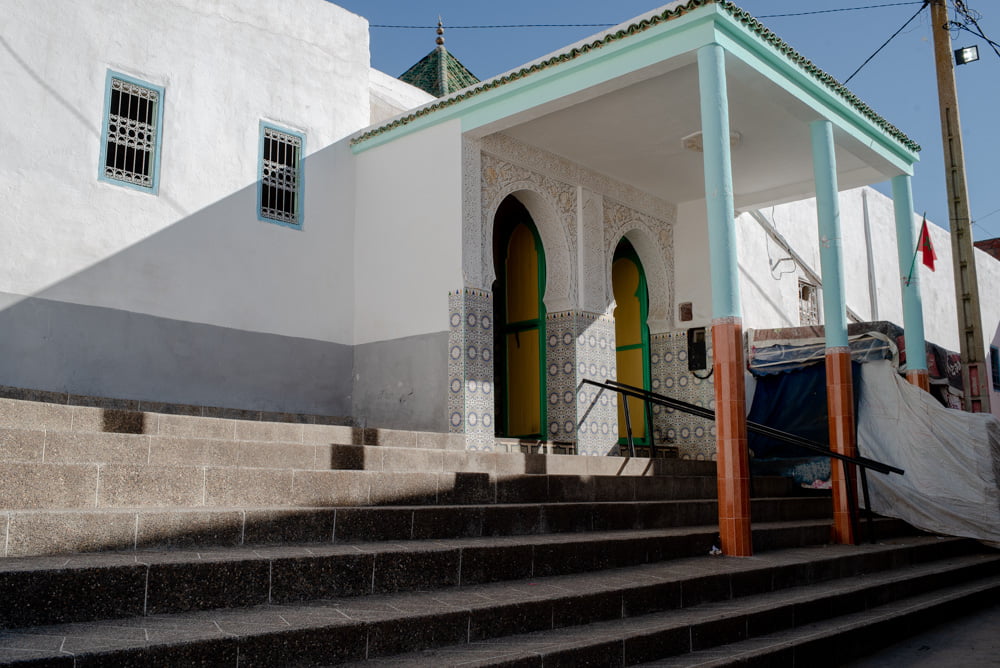
The zaouia of Sidi Ahmed containing both his mausolem, a shrine to Aisha Qandisha where offerings and sacrifices are received, blessed and the jinn invoked and a separate chamber beside Sidi Ahmed’s mausoleum where animal sacrifices are made.
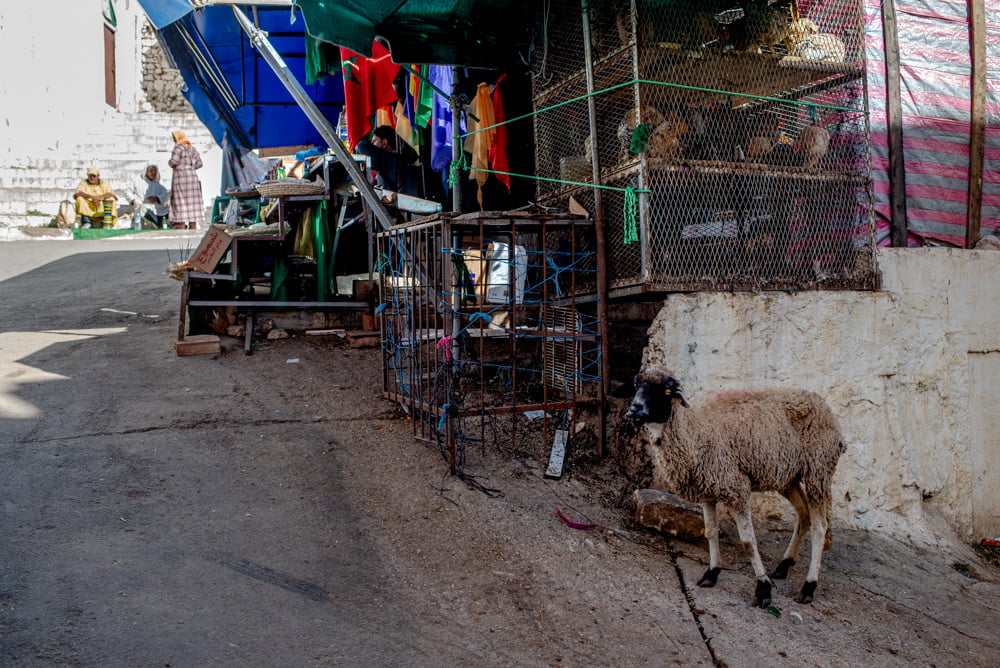
Stall directly opposite the entrance to Sidi Ahmed’s zaouia selling offerings for Sidi Ahmed and animals for sacrifice as well as shawafa products to honour Aisha Qandisha
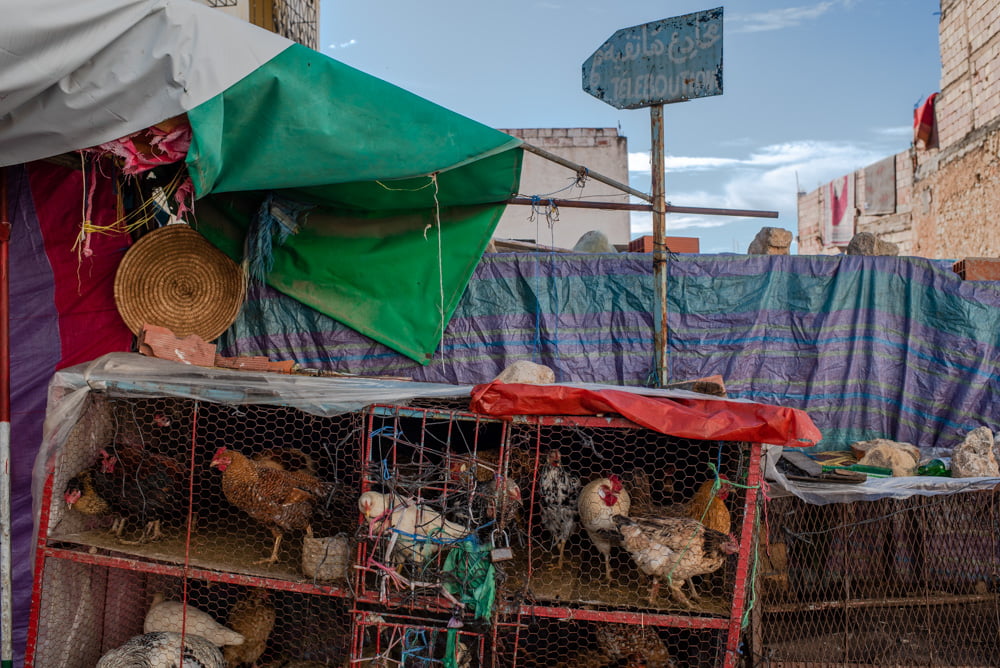
According to legend, one of Aisha Kandisha’s favourite offerings is hens and cocks. Again this stall was close to the zaouia.
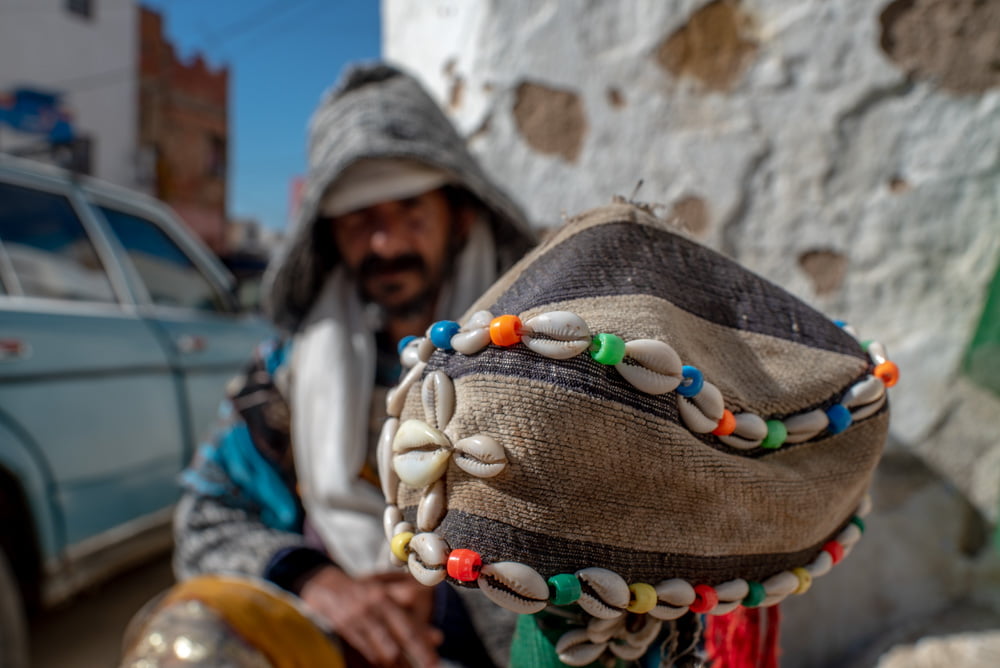
A pilgrim who told me he travels across north Africa visiting and living at Hamachda zaouias. He was reluctant to have his photograph taken but did agree for to photograph his shell rimmed hat. He also had a small collection of other possessions, all colourful, organic and congruent with the Sufi philosophy,. He lived off alms.
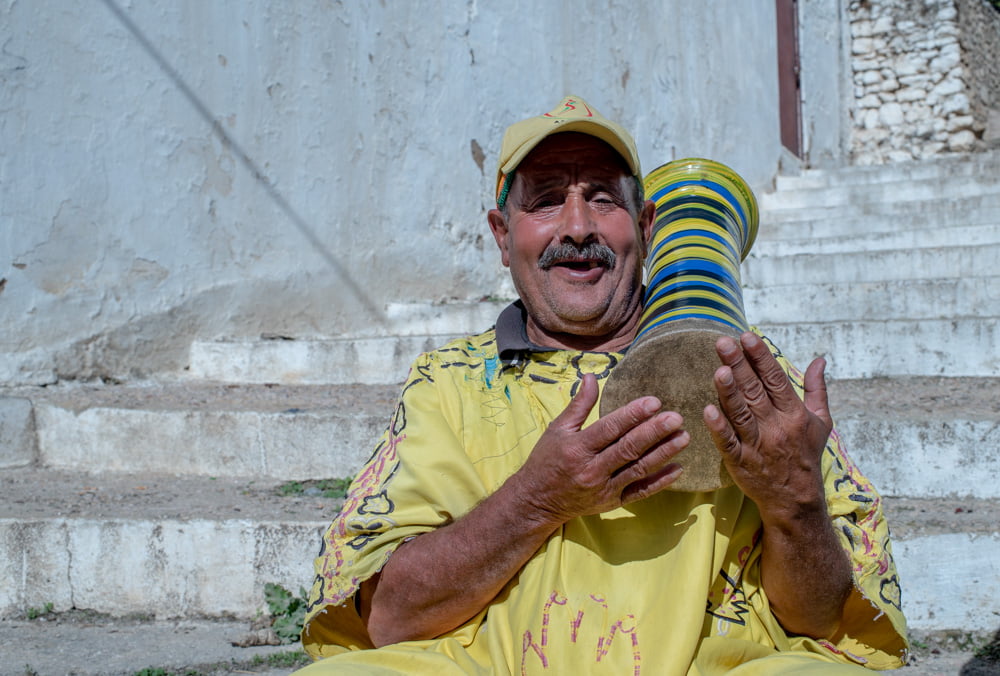
A follower of the Hamachda brotherhood providing a demonstration of him playing his clay drum. He showed me the self inflicted scars on his scalp obtained whilst undertaking Hal ( ecstatic dance ). Such self harm is far less prevalent today. He too was hoping for alms by sitting beside the zaouia.
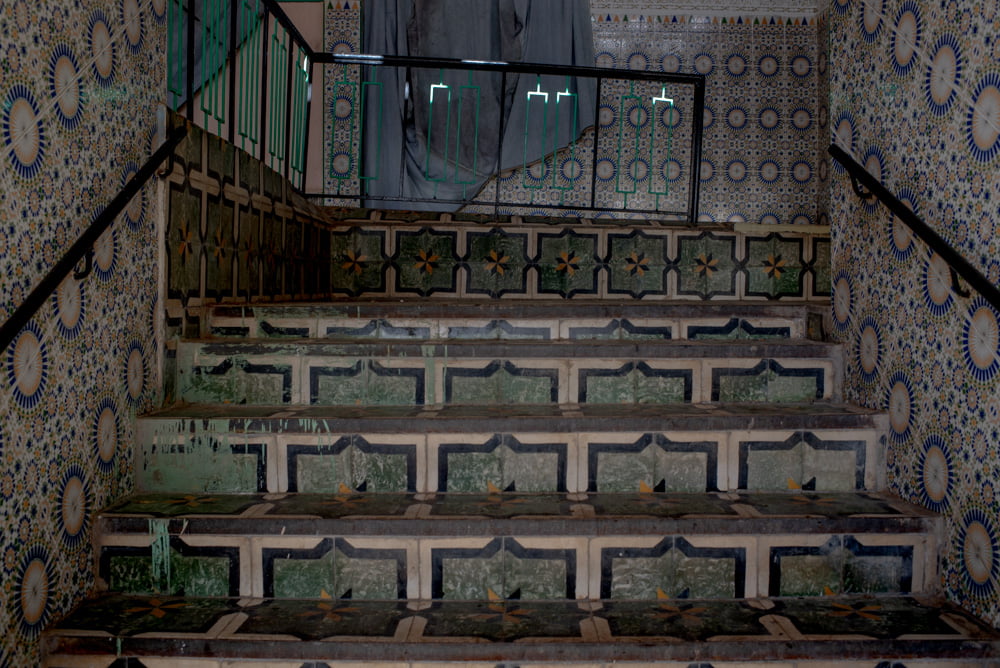
Entrance into the zaouia. I was intrigued by the little bands of light playing on the balustrade. The patterns of tiles are different at every zaouia, but architectually the use of tiles is ubiquitous.

Taking photographs inside the zaouia was extremely difficult; photography was officially not allowed but I managed to discretely take several photographs but none of the mausolem of Sidi Ahmed or the shrine of Aisha where sacrifice occurred. Both rooms were busy and I was ( rightly in all honesty ) regarded with perpetual suspicion.
A devotee with an offering approaching the caged area where the clairvoyant ( seen sitting down ) received the offerings, provided blessings and invoked the djinn. All for a little money. She approached me, asking me to pay her some money for a blessing. I graciously demurred.
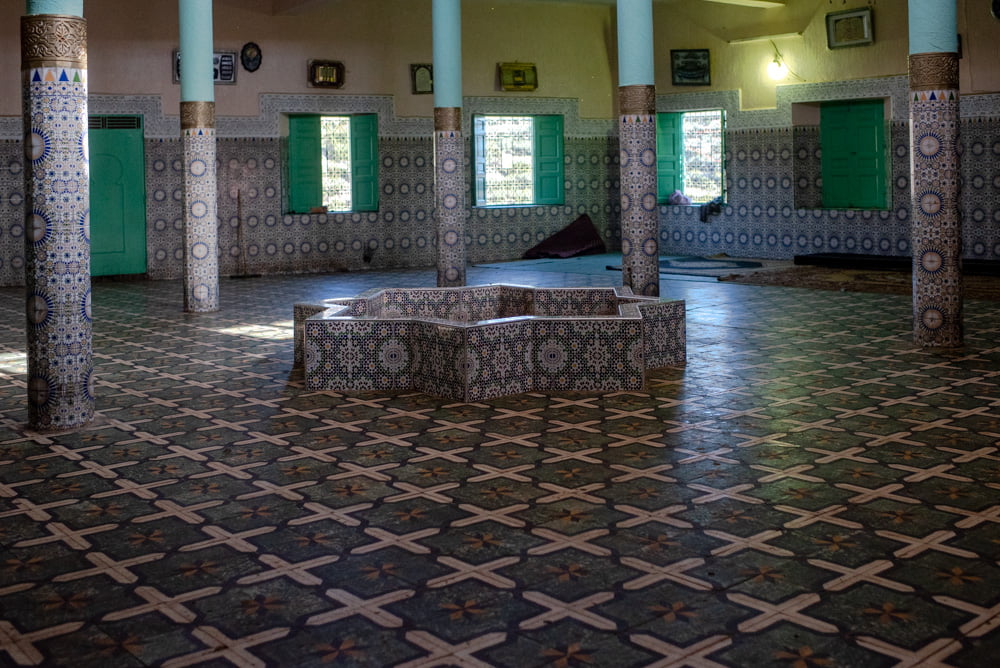
This beautiful area is to the left of the clairvoyant and directly outside of the mausoleum of Sidi Ahmed and the sacrifice room of Aisha Kandisha. It was impossible to navigate further into the zaouia without greater scrutiny.
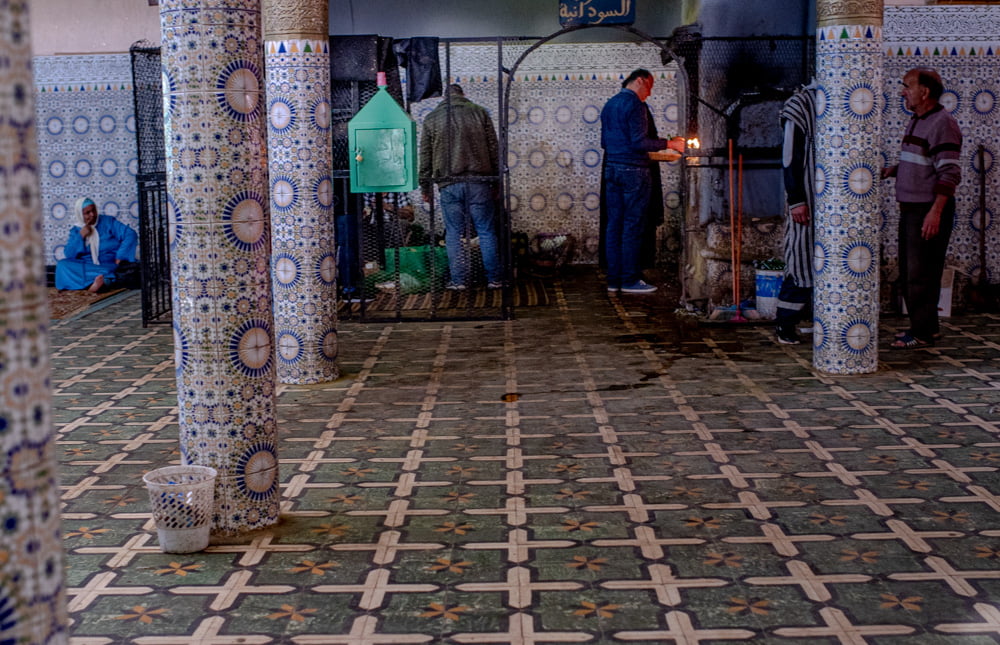
A close up view of the caged area with the clairvoyant. The devotee lights some candles to Aisha and receives the blessing from the seated clairvoyant.
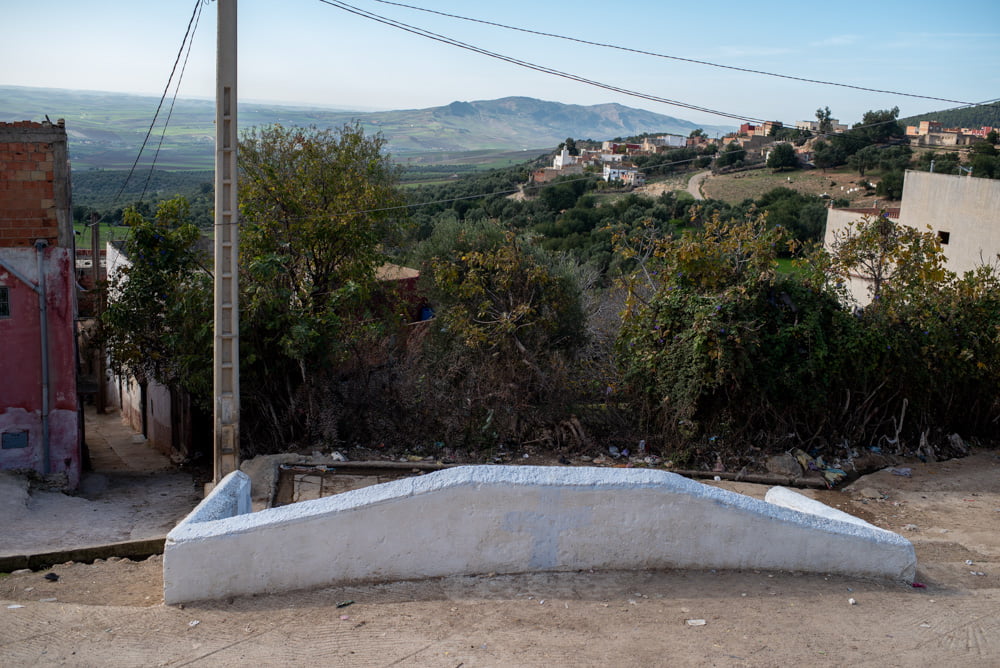
Leaving the small town of Sidi Ahmed, the adjacent town of Sidi Ali can be seen across the ravine. It is just a 20 minute stroll between the two towns.
Aisha Qandisha
In Sidi Ali, Aisha Qandisha has 2 separate shrines. The first is under a great old fig tree. This is quite a large area, with a separate sacrificial area behind iron bars, a raised dias where the male clairvoyant sits and a raised alter under the fig tree roots where henna is scattered and candles lit. There is another area beyond this where shawafa appears to happen; a bucket of coals is kept alight and incense burnt for people to inhale. Across the walls here on one side words are written in dried henna; on the opposite side candles are lit and the wall is blackened with constant candle fire and smoke.
The second is at the foot of Ayn Kabir, the baraka invested spring which flows from the cliff under Sidi Ali’s tomb. Her shrine here seems exclusively orientated towards healing as devotees bath in the waters of the spring, discard old clothing in the trees there and then, wearing new clothing, walk up the several steps to Aisha’s shrine, covered in henna and candles.
In Sidi Ahmed, Aisha Qandicha’s shrine is an inclusive part of Sidi Ahmed’s zaouia. Inside there is firstly a caged area with a shrine and candles where a clairvoyant receives offerings, says prayers to invoke the djinn and prepares for animal sacrifice. The animal is then taken across the inner space where sacrifice occurs in a room next to the tomb of Sidi Ahmed.
Ashia Qandisha is a she-demon, sometimes called a jinniyya or female jinn, sometimes an afrita, or giant jinn-like creature, and sometimes she is considered to be quite different from either of these. She is said to appear sometimes as a beautiful woman and sometimes as an old hag, but always with the feet of a camel or some other hoofed animal.
Despite a widespread belief in Aisha Qandisha among the northern Moroccan Arabs, the Hamadsha are her special devotees. Following her abduction by Sidi Ahmed they hold her responsible for their trance, capable of both healing devotees and terrorising her victims.
Although her Sudanese origin is almost universally accepted, it has been claimed that she was in fact a woman and Sidi Ali’s slave/helper and that when he was buried she suddenly disappeared and was heard laughing. “I am here,” she called out “I am dead. I’ve been carried away by my numduk (jinn).” The myths overlap.
Some tell that she is the daughter of Sidi Shamharush, the king of the jnun; others suggest that her mother was human and that Ather Ighud, the shepherd of the wind, carried her mother off to the forest. This suggests
One theory is that she is among the most powerful and renowned of all Djinn. Another is that she is Astarte reduced to hanging out at hot springs now that her temples are shut, enlisting her own devotees and supplying her own human sacrifices. She may be Kadesh, the sacred harlot. Aisha may have been brought to Morocco by Jews or Phoenicians, or she may be an indigenous Berber water spirit.
Those evening encounters at springs aren’t random. She knows exactly who she’s looking for. The standard Aisha Qandisha legend suggests that if a man runs from her, she calls him by name. She knows who he is. If he can reach the company of others, he’ll be safe. If she catches him, she may drag him into the river to drown. Alternatively, she’ll ask him to make love to her. If left unsatisfied, she may then drown him, but sometimes if a man pleases her, she bestows generous gifts and spiritual protection.
Some though not all men who survive encounters with Aisha Qandisha pine for her, losing interest in human relationships. They may be treated and healed by the various Brotherhoods who venerate Aisha Qandisha. Aisha Qandisha engages in three types of relationships:
- Very brief relationships in which she causes harm
- Warm relationships in which she offers assistance. Maintain a home altar for her or offer an annual lavish offering or pilgrimage.
- Very intense relationships, especially with men whom she may marry.
She can be a very demanding spirit who insists that devotees dress only in her sacred colors or that male devotees never cut their hair or fingernails. She may order that men wear only old, worn, dirty clothing (essentially isolating them from conventional society). No need to volunteer any of this. If she wants something, she’ll tell you.
Should one already possess a human partner or hope to have one in addition to Aisha, it is very crucial that this be brought up and negotiated when she first proposes marriage. Terms may be negotiated. Both sides may request giftsand lay down rules for the relationship. Aisha Qandisha may impose sexual restrictions on male devotees:
• They may have sex only with her.
• They may have sex only with her and a human spouse.
• They may have sex only with her and her female devotees.
Aisha Qandisha is associated with mud, Earth, springs, and rivers. She may render a man impotent, control his virility, or conversely bestow superhuman sexual powers. She preserves and enhances good health, good fortune, fertility, and virility when she chooses. She causes and heals the following:
• Paralysis, especially if sudden or unexplained
• Sudden deafness, blindness, and/or muteness
• Children’s illnesses
• Menstrual problems or infertility
Aisha Qandisha may cause any of the above ailments if annoyed or displeased. She may also be petitioned to remove and heal them, whether or not she is the cause. (She has dominion over these ailments and can undo another spirit’s damage or curse.) If she fulfills a request or petition, make sure to pay her what was promised and quickly or she will attack. She’s a temperamental, volatile spirit, quick to scratch, strangle, or whip those who displease her or don’t obey her commands fast enough.
Manifestations: Aisha Qandisha usually looks like a gorgeous woman, but typically with some little giveaway that she’s more than that, such as one goat, camel, or donkey foot. She wears long robes as camouflage; the animal leg may not be immediately apparent. She also appears as a wizened hag with pendulous breasts. Alternatively she manifests with a woman’s head, breasts, and legs and a goat’s body, or as a pregnant goat with a woman’s legs. Her hair often forms snake-like curls. When Aisha wishes to travel incognito, she takes the form of a wasp. Apparitions of Aisha tend to occur near water or fig trees.
Colors: Black, red, chartreuse green
Incense: Black benzoin resin (Styrax benzoin)
Birds: Black, red, and multicolored (“seven-colored”) hens
Animals: Wasp, pig—a subversive animal for a spirit haunting the fringes of the Muslim world. Those entranced by her sometimes roll around in mud or squeal like a pig.
Sacred sites: Caves, forests, freshwater springs, rivers, and the seashore; Aisha Qandisha has a grotto beneath a giant fig tree near the tomb of the Moroccan holy man, Sidi Ali ben Hamdush. It is traditional to light candles for her before sleeping in the grotto in attempts to establish contact with Aisha or receive a healing dream.
Sacred trees: Fig; henna shrubs
Consort: Hammou Ukaiou
Elements: Water, earth (especially watery earth: mud, marshes, the shore)
Offerings: Amber, honey, cowrie shells, bread, olives. Burn candles for her. Adorn yourself with henna in her honor. When making vows to Aisha, it’s traditional to tie bits of fabric to a tree (preferably fig) as testament.
Aisha Qandisha: Paths
Aisha Qandisha may be one single spirit who demonstrates different sides of herself to different individuals or groups of people. Alternatively, there may be a family or sisterhood of Aisha spirits, similar to the various Vodou Fredas or Simbis, who may or may not all be the same spirit. Another theory suggests that the various paths of Aisha Qandisha are actually her daughters.
Lalla Aisha’s different paths are distinguished by the time of day preferred for outings. Some paths of Lalla Aisha only venture out at twilight or after dark. Others prefer the cool of the morning. While the standard description of Aisha Qandisha classifies her as a Berber or Semitic spirit, some paths emphasize her origin in sub-Saharan Africa.
Each path of Aisha has a slightly different personality, responds to different songs, and expects slightly different offerings. Each Aisha has a Moroccan saint whom she favors; she may reside or be invoked near that saint’s shrine. Devotees of the saint propitiate her. In this context she is almost inevitably addressed as Lalla Aisha, literally Lady Aisha.
Paths of Aisha Qandisha
LALLA AISHA DGHUGHA
Lalla Aisha Dghugha, also known as Lalla Aisha Dghughiyya, is associated with the Hamadsha Brotherhood and their presiding saint, Sidi Ahmed Dghugli, whom she served. Some say she was his spirit wife. She strolls after afternoon or evening prayers. Lalla Aisha appears at her small muddy pit in the corner of Sidi Ahmed’s tomb in Beni Ourad, especially during dance rituals. Black hens are vowed to her at this shrine. Do not kill the chicken! (These are her sacred birds; she can be very protective of them.) A live black hen is given to the shrine keeper at this particular shrine. He kills the hen: the blood is poured out for Lalla Aisha, and then the chicken is cooked and distributed to the poor.
Colors: Black, red
Incense: Harmal (Peganum harmala); red benzoin
Animal: Horse
Attribute: Cowrie shells
LALLA AISHA GNAWIYYA
Lalla Aisha Gnawiyya is Lalla Aisha as venerated by the Gnawa Brotherhood, who consider her a Djinn or Melk. She strolls at night.
Colors: Black, yellow
LALLA AISHA HASNAWIYYA
Lalla Aisha Hasnawiyya is associated with Beni Hsen, near Rabat. She walks only in the early evening (the first few hours after evening prayers).
Colors: Black, red
Incense: Tar (Qatran), which allegedly ban ishes Djinn, although clearly not Lalla Aisha
LALLA AISHA SUDANIYYA
Lalla Aisha Sudaniyya literally means “Sudanese Lady Aisha.” “Sudan” does not refer to the modern East African nation but to Africa south of the Sahara. She is venerated by the Hamadsha Brotherhood and has a grotto at the shrine of their saint, Sidi Ali ben Hamdush, in the village of Beni Rachid. Sidi Ali lived (and the Hamadsha emerged) during the reign of Moulay Ismail,who imported countless black slaves to labor on building projects and serve as his private guard, creating a profound sub-Saharan African influence and presence in Morocco. Lalla Aisha Sudaniyya may or may not be the same spirit as Lalla Aisha Dghugha:
• She may be a spirit from sub-Saharan Africa.
• She may be a woman who worked for Sidi Ali ben Hamdush as a servant or slave, then disappeared after his death.
• She may be the daughter of Chemharouch, King of Djinn.
• She may be the child of a spirit, Ighud, Shep herd of the Wind, and a human mother.
Her grotto near Sidi Ali’s tomb is banked on one side by the root system of an enormous fig tree. Pilgrimage to her grotto, especially in conjunction with pilgrimage to Sidi Ahmed and Sidi Ali’s tombs, allegedly provides miracle healings of infertility, children’s illnesses, and diseases caused by Lalla Aisha herself. Tie bits of rags, ribbons, or fabric to the tree as testament to vows made to Aisha. (The traditional vow is to promise to return and offer a black hen if she fulfills your request.)
See also: Aisha Qandisha; Chemharouch; Djinn; Lalla; Melk
From the Encyclopedia of Spirits: The Ultimate Guide to the Magic of Fairies, Genies, Demons, Ghosts, Gods & Goddesses – Written by : Judika Illes
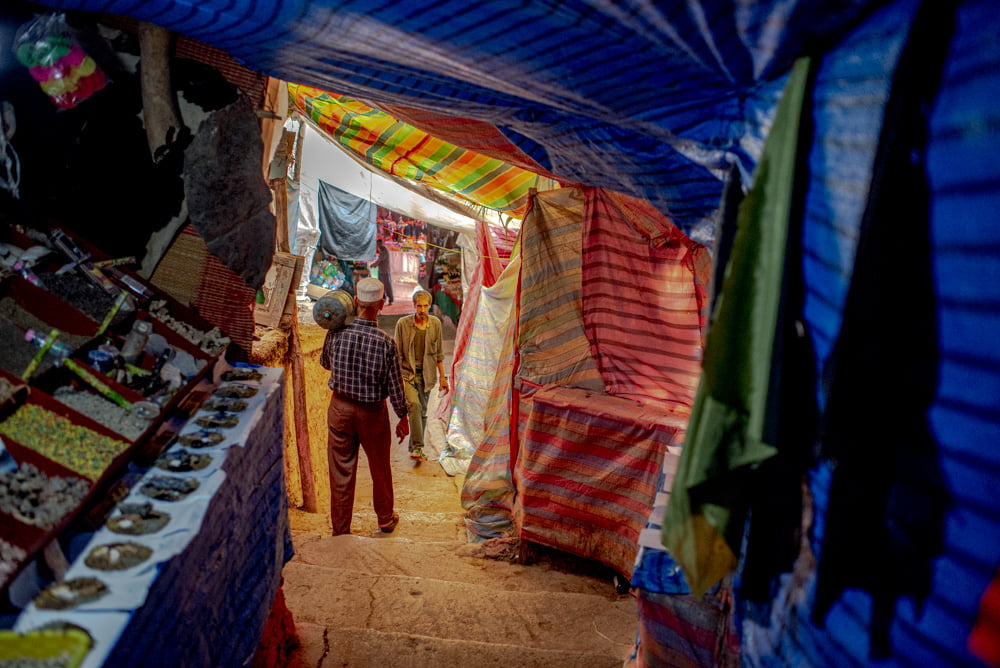
Covered pathway leading down to the douche of Ayn Kebir, the spring of healing water which rises from the cliff beneath Sidi Ali’s tomb, alongside the shrine to Aisha Qandisha. The corridor is lined with stalls selling shawafa items.
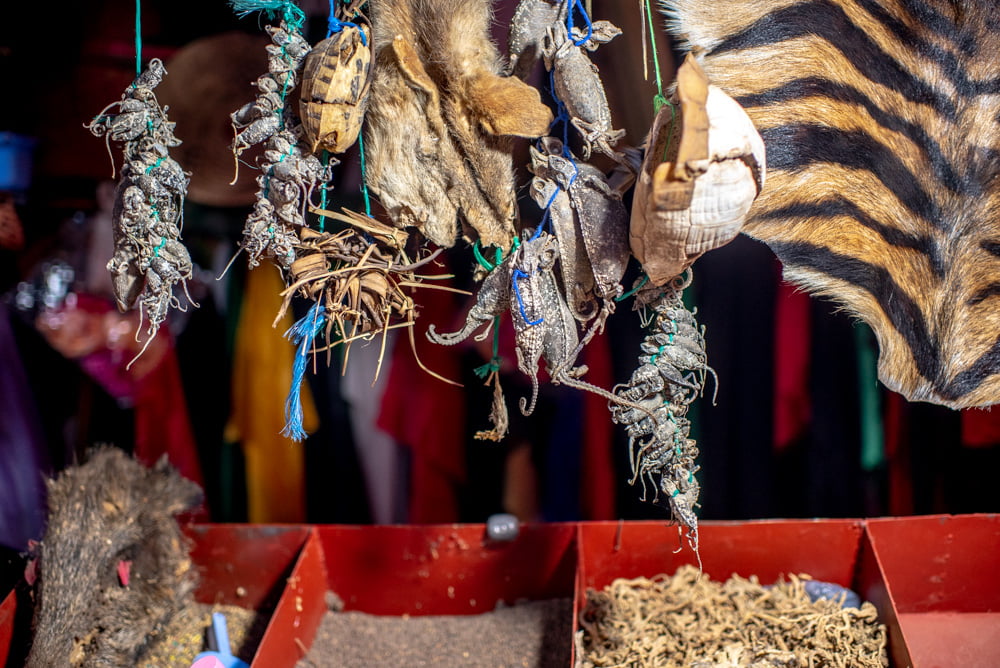
Examples of shawafa items for sale in the corridor leading to the douche and Aisha Qandisha’s grotto. The smaller animals are boiled in water and the steam used to bring about change, either healing or attempts to communicate and appease with a spirit.

Examples of shawafa items for sale in the corridor leading to the douche and Aisha Qandisha’s grotto. The smaller animals are boiled in water and the steam used to bring about change, either healing or attempts to communicate and appease with a spirit.
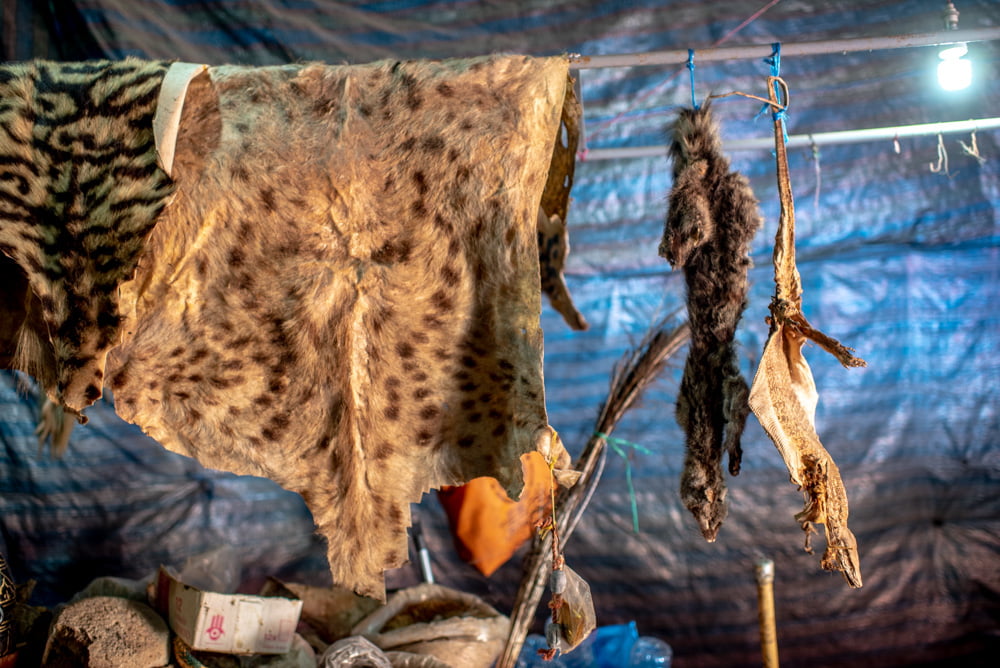
Examples of shawafa items for sale in the corridor leading to the douche and Aisha Qandisha’s grotto. The smaller animals are boiled in water and the steam used to bring about change, either healing or attempts to communicate and appease with a spirit.
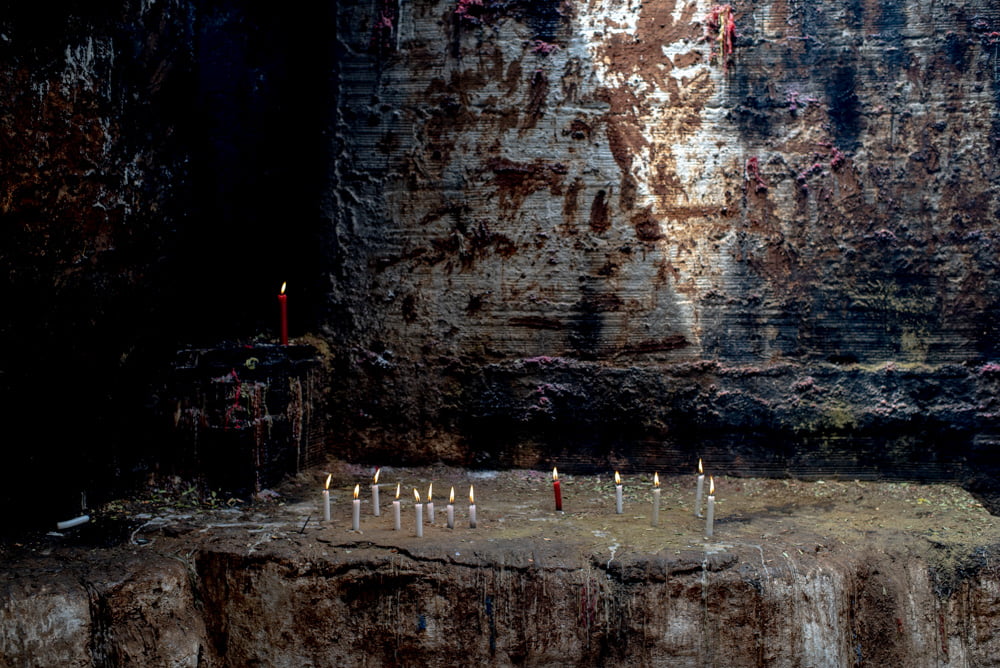
Candles in the rear chamber at the cave of Aisha Qandisha underneath the roots of the fig tree. Animal sacrifices to Aisha is made in the anterior room; in this space shawafa occurs with incense being burn on a brazier. Henna is spread thickly on the walls turned mostly black through candle flame.
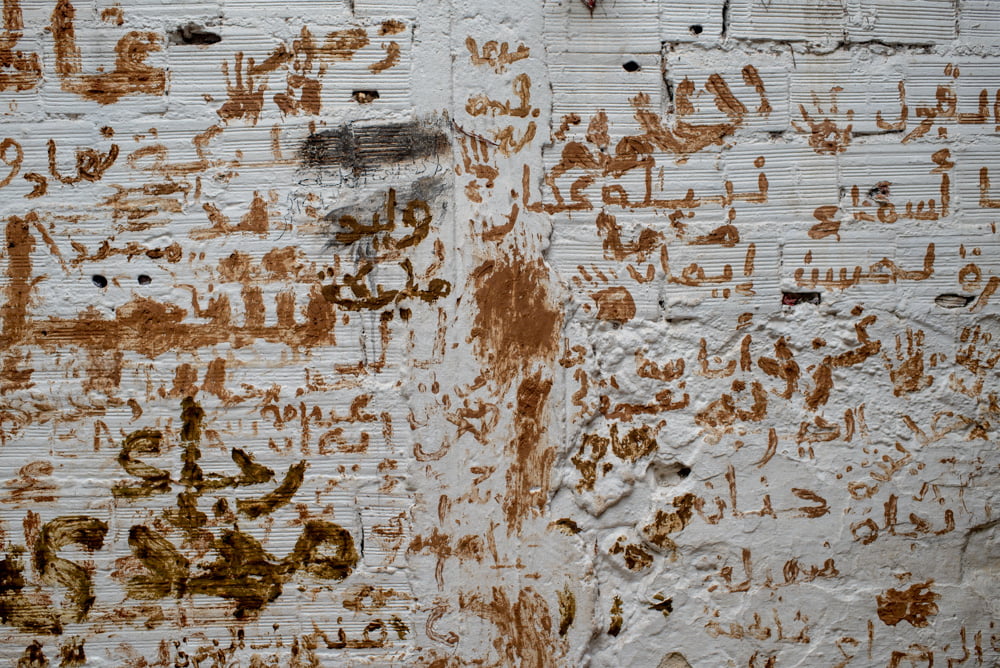
Henna writing on the wall of the rear chamber of Aisha Qandisha’s cave beneath the roots of the fig tree. Someone at the shrine said this particular part of the shrine was to do with blessing a marriage; I have no idea of the veracity of that.
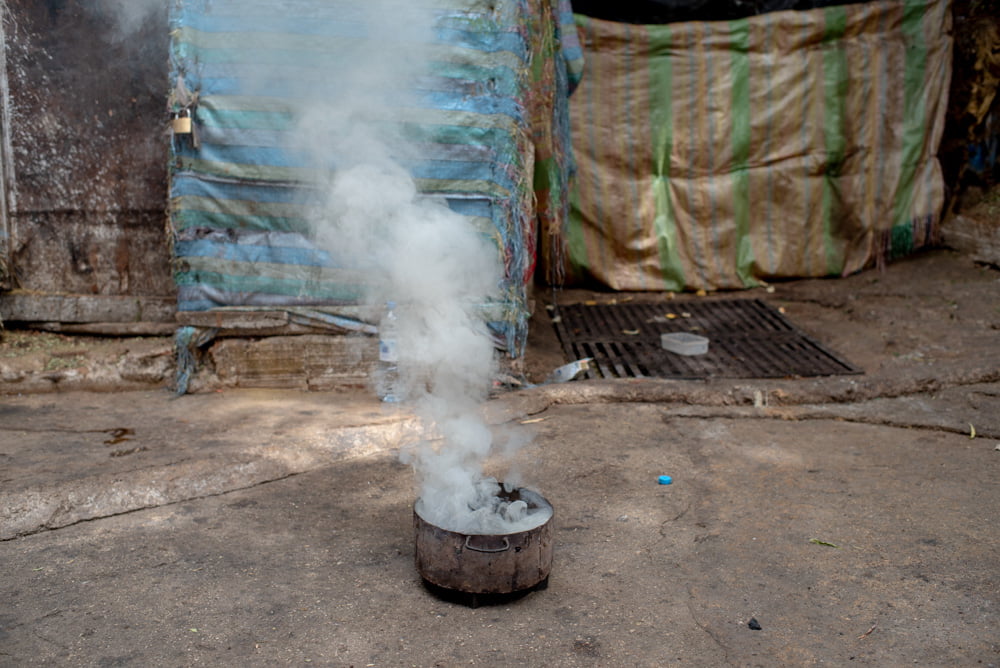
Incense being burnt in the rear room of Aisha Qandisha’s shrine beneath the roots of the fig tree. This is an example of shawafa ( divination/witchcraft ) where a person stands over the brazier and breathes the incense deeply.
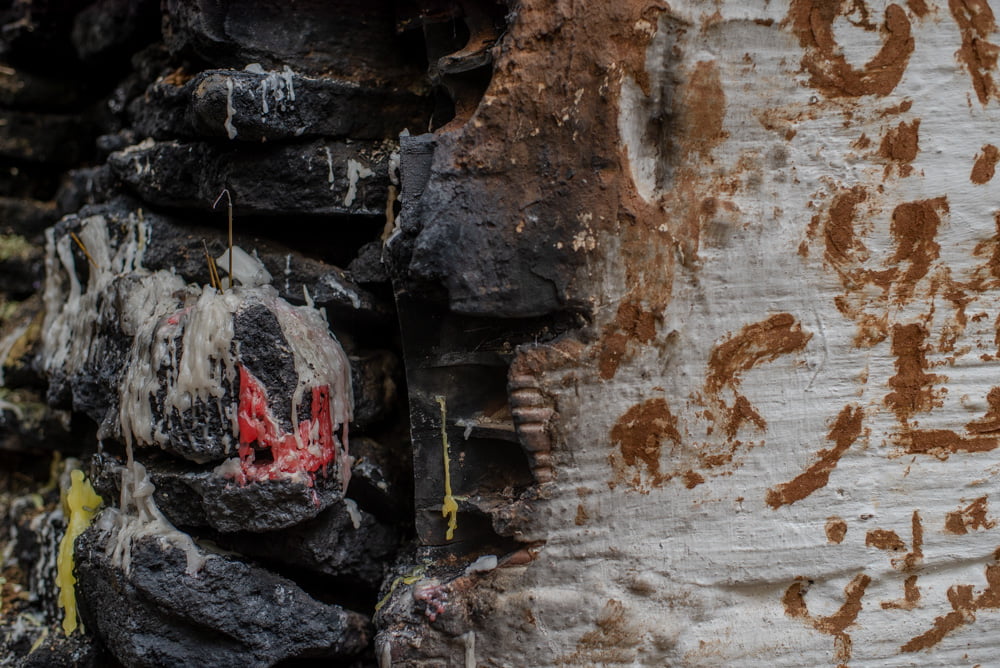
A small shrine and henna writing in the rear room of Aisha Qandisha’s cave under the fig tree roots at Sidi Ali.

The entrance to Aisha Qandisha’s grotto next to the douche from the Ayn Kebir spring water. There is an alter on the right of the grotto where henna leaves are spread and candles lit, as prayers are offered.
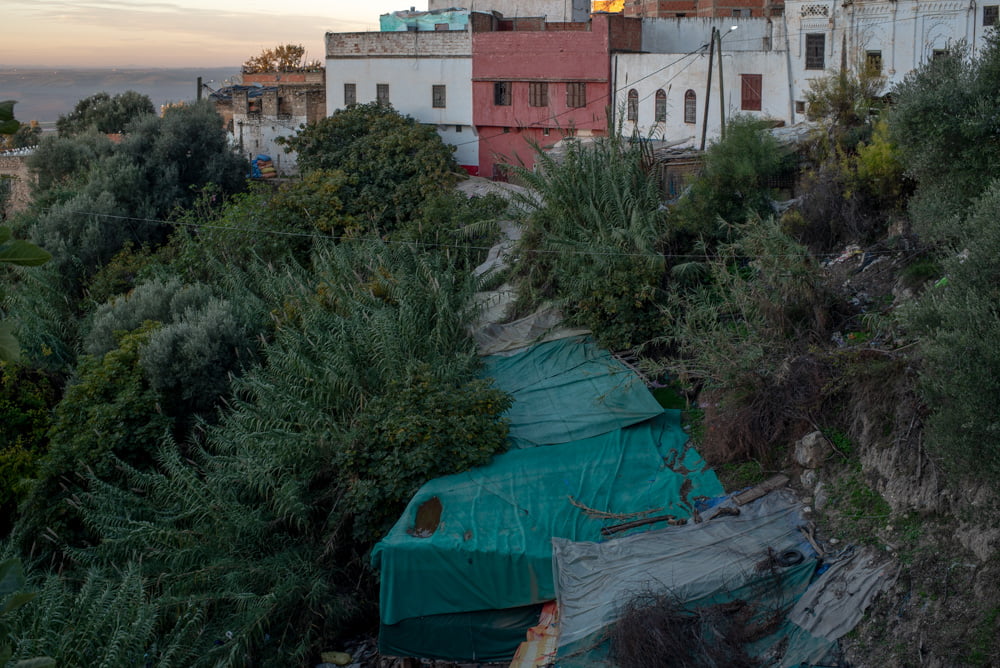
A photograph from Sidi Ali’s zaouia of the covered corridor leading to the douche from the Ayn Kebir spring of healing water rising from beneath Sidi Ali’s tomb.

The douche where people bath and receive healing from the spring water infused with the baraka of Sidi Ali. The grotto of Aisha Qandisha is just yards to the left, up several steps.

The tree where clothing is deposited as a symbolic gesture that healing has occurred. Dispensing with clothing can either suggest the healing is instantaneous or will occur as the clothing in the tree degrades.
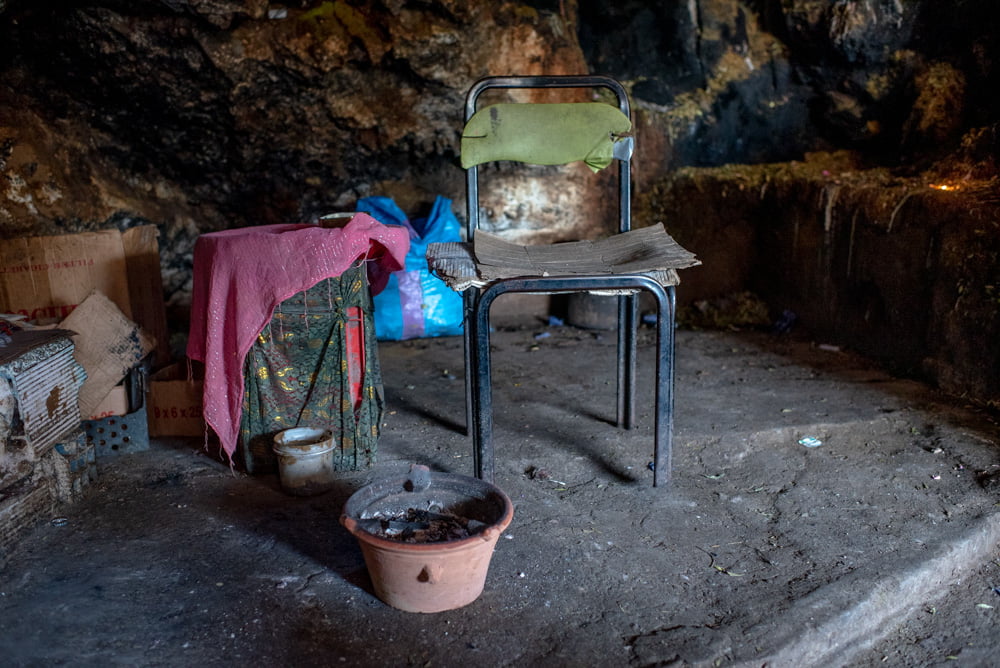
Inside the grotto of Aisha Qandisha, this is the chair and collection tin used by the clairvoyant who sits in the shrine receiving offerings, saying prayers and generally managing the shrine.
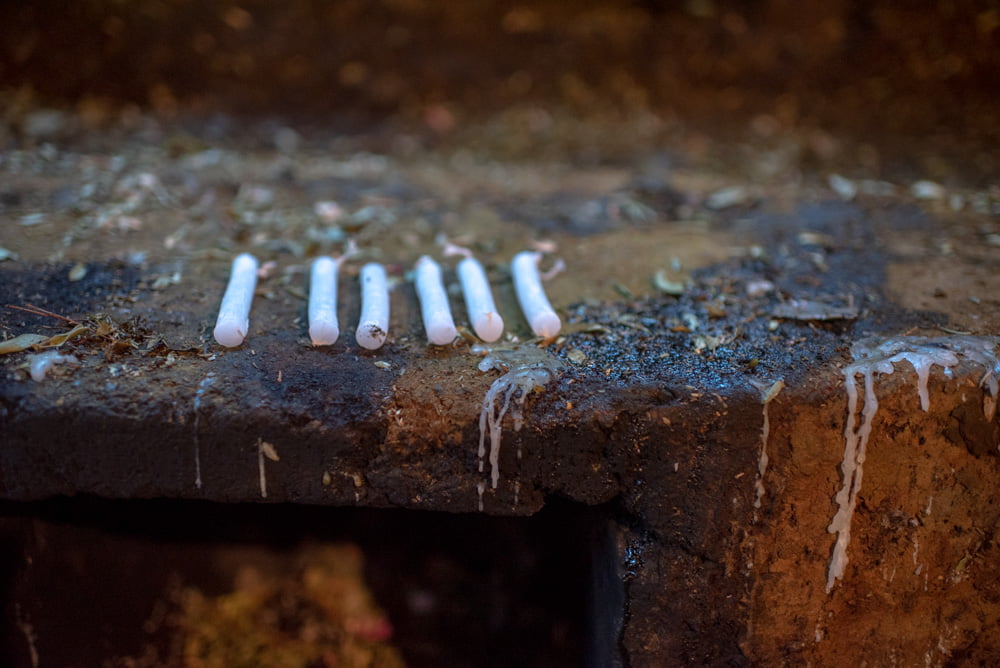
Candles and candle wax at the grotto of Aisha Qandisha besides the douche and spring water infused with baraka of Sidi Ali.
Addendum : Further Information regarding the relationship between Henna and Aisha Qandisha, and a explanation of the Saint’s mystical powers of Baraka
Role of Henna in contact with Aisha Qandisha
This information is taken from here
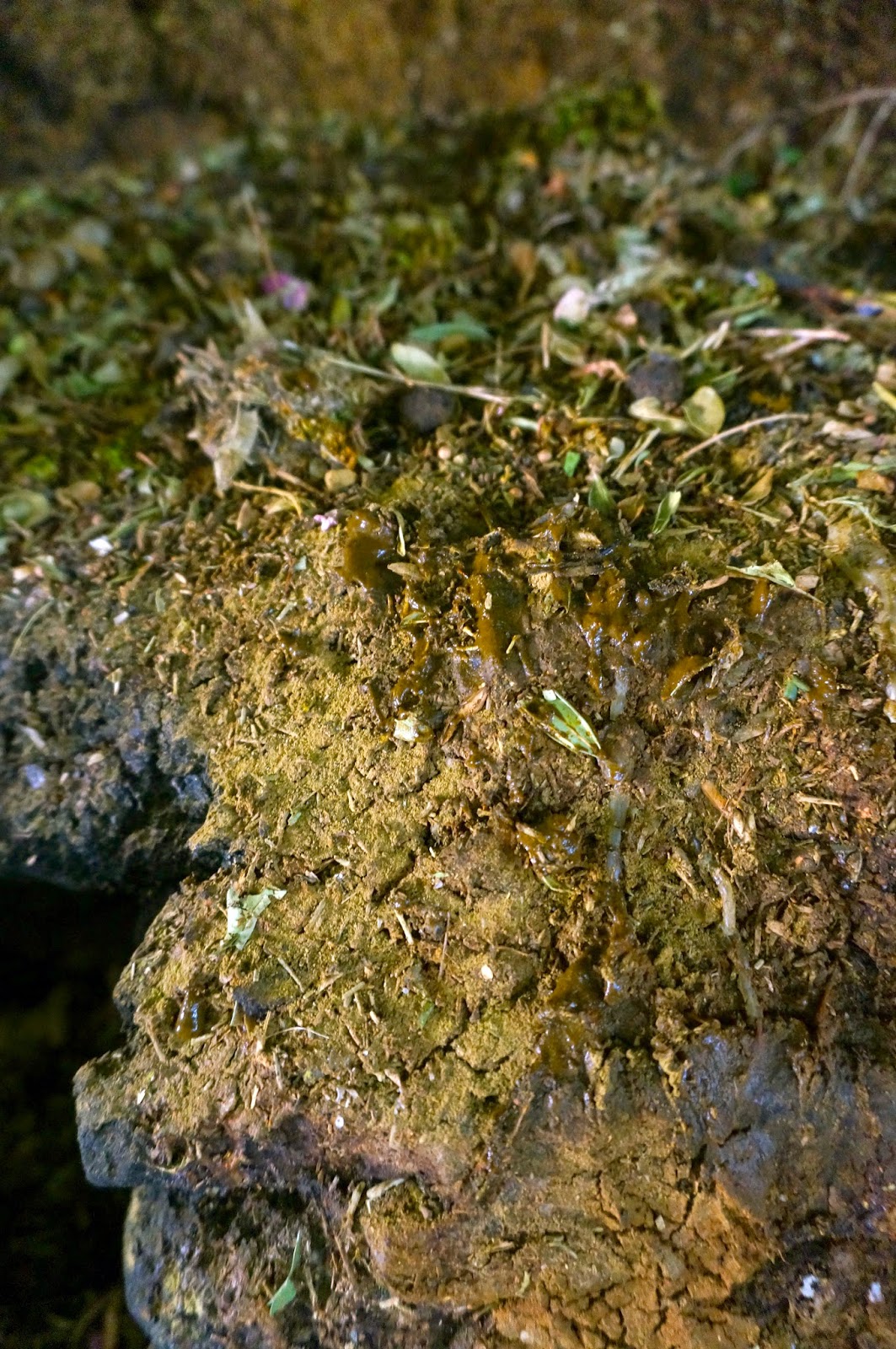 |
| Henna and wax on the walls of ‘Aisha’s grotto. |
| Trays of offerings for Lalla ‘Aisha in Sidi ‘Ali ben Hamdouche. |
She is always libidinous and quick-tempered. She never laughs, and she is always ready to strangle, scratch, or whip anyone who insults her or does not obey her commands… She may appear to believers either as a beauty or as a hag with long pendant breasts. Usually, even in her beautiful manifestations, she has the feet of a camel, a donkey, or an ass.
| This woman identified her henna as l-ḥinna dyal ‘Aisha, ‘the henna of ‘Aisha.’ See another example of henna for ‘Aisha in this post. |
Lalla Malika is very beautiful and dresses, as they say, with a lot of chic. She demands the same elegance of all her followers. She is a flirt and quite promiscuous, and she especially enjoys relationships with married men. I have been told she speaks only French… She likes to laugh and tickle [her followers], and she is responsible when a group of women suddenly start giggling.
| This woman told me she had done this henna for Lalla Malika. |
She lives in houses and takes her walks after afternoon prayers… She makes people laugh, but also attacks and takes possession of them. She is unmarried… Lalla Mira can attack someone who is laughing or crying a lot. Sometimes a woman who is crying is suddenly paralyzed. She continues to cry as long as she is paralyzed. You must then put henna in her hands, in her mouth, and in her nose.
| I came home one day to find that my host grandmother (also from a small Amazigh village!) had hennaed her hands to help with her joint pain, and also ‘just because’. |
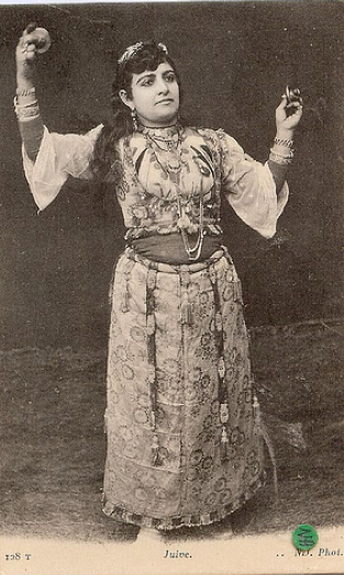 |
| Jewish hennaed dancer, Algeria, early 20th century. |
It has been described in the following way : “Literally, “baraka” means blessing, in the sense of divine favour…. It encloses a whole range of linked ideas: material prosperity, physical well-being, bodily satisfaction, completion, luck, plentitude, and, the aspect most stressed by Western writers….. magical power. In broadest terms, “baraka” is not, as it has so often been represented, a para-physical force, a kind of spiritual electricity a view which, though not entirely without basis, simplifies it beyond recognition …… it is a conception of the mode in which the divine reaches into the world, implicit, uncriticised, and far from systematic, it too is a doctrine.” Clifford Geertz 1968
It can also be considered as a mode of construing—emotionally, morally, intellectually—human experience, a cultural gloss on life. And though this is a vast and intricate problem,what this construction, this gloss, comes down to, … is the proposition ( again, of course, wholly tacit ) that the sacred appears most directly in the world as an endowment – a talent and a capacity, a special ability – of particular individuals. Rather than electricity, the best (but still not very good) analogy for “baraka” is personal presence, force of character, moral vividness. Marabouts [saints] have “baraka” in the way that men have strength, courage, dignity, skill, beauty, or intelligence. Like these, though it is not the same as these, more even thanf all of them put together, it is a gift which some men have in greater degree than others, and which a few, marabouts, have in superlative degree. The problem is to decide who (not only, as we shall see, among the living, but also among the dead) has it, how much, and how to benefit from it. Vincent Crapanzano in The Hamadsha: A Study in Moroccan Ethnopsychiatry
There are considered to be two types of baraka:
- institutionalized baraka, which is inherited by descendants of saints and of the Prophet Mohammed; such baraka cannot be diminished, but it can be transmitted to others. A surrogate form of this transfer is for the saint to take a student and cultivate a relationship of subservience and duty thereby emulating a paternal relationship. In this way, baraka is transmitted and inherited over a period of time. This is how Sidi Ahmed received baraka from Sidi Ali.
- personal baraka, which is acquired/earned in one’s lifetime through personal merit and depends on character, piety, spirituality, moral fiber, and natural gifts (such as the gift of healing); such baraka is not inheritable, but it can be transmitted. Personal baraka is not something that one can hoard and use at a later date; rather, it manifests itself immediately in good health, fertility, or good fortune. Baraka can be received/acquired directly or indirectly by contact with someone or something possessing a lot of baraka.
Sidi Ali was believed to have obtained his baraka by surreptitiously drinking all the water from the water bag of Bu-abid Sharki, another saint, who had previously bestowed baraka to others by allowing 40 people each year to drink from his bag. Following discovery of the theft, Sharki ordered his men to chase Sidi Ali to Marrakech where, after he performed some miracles, he was considered a Saint.
- Henna has intrinsic baraka that benefits those who apply it to their skin or hair. Repeated application of henna is required to continue the transmission of baraka. The use of henna for important events such as weddings and circumcisions ensures that participants, who may be in a vulnerable state during these events, are endowed with baraka to protect and bless them.
